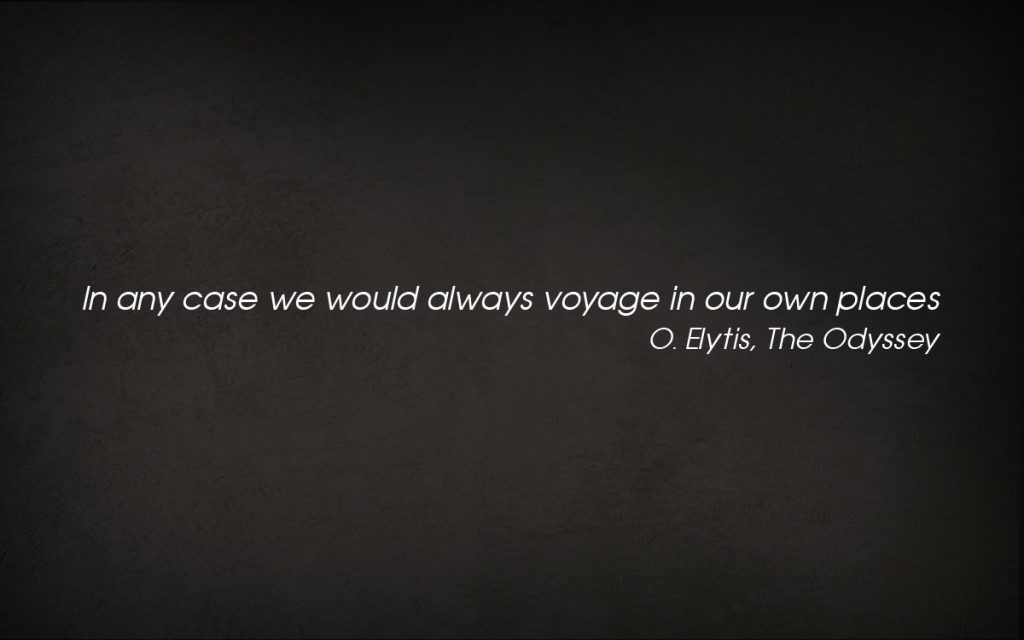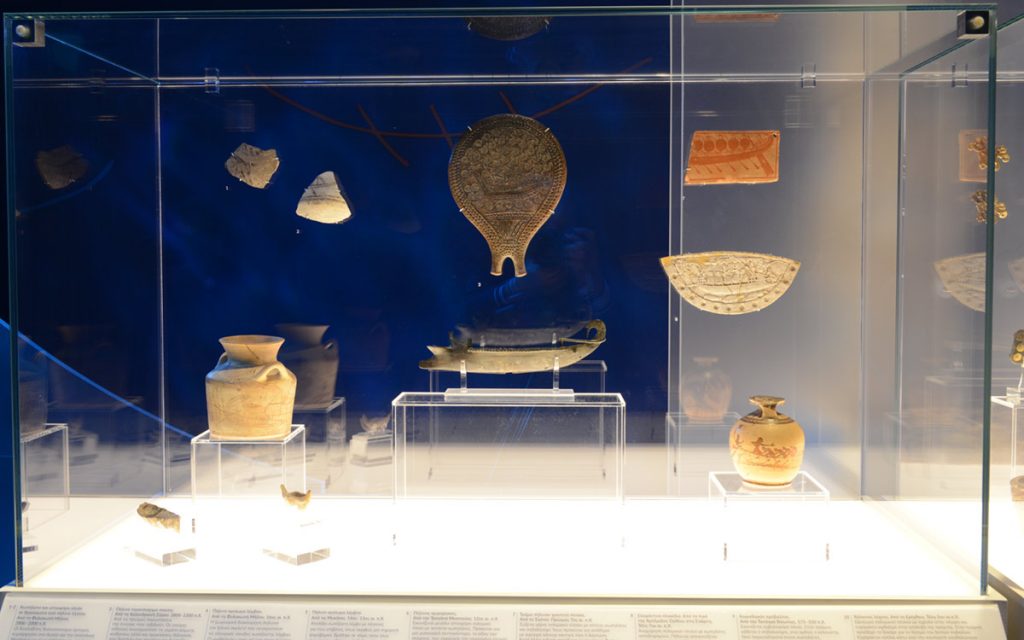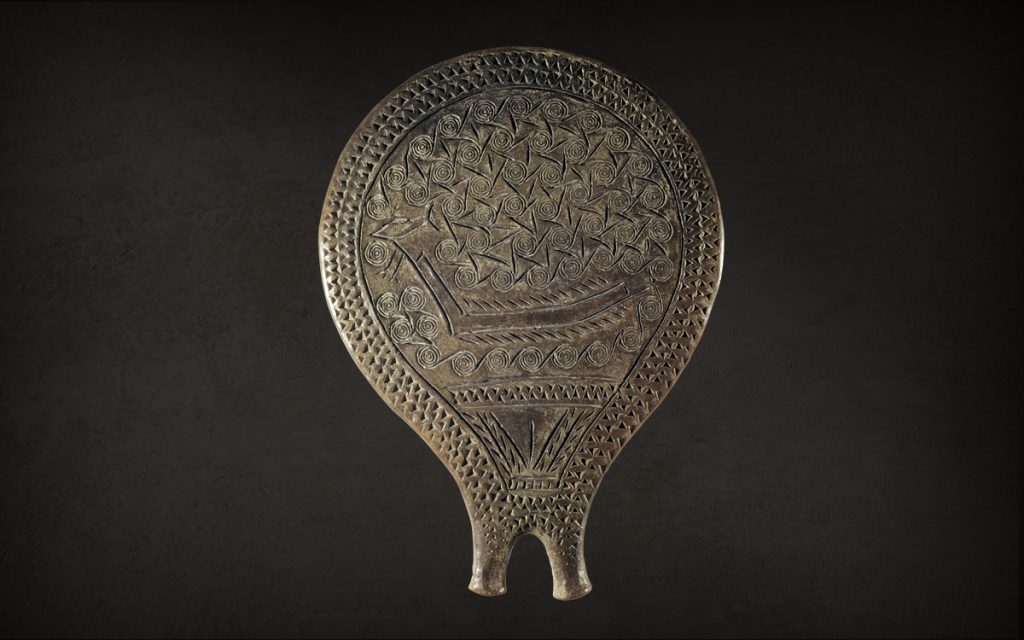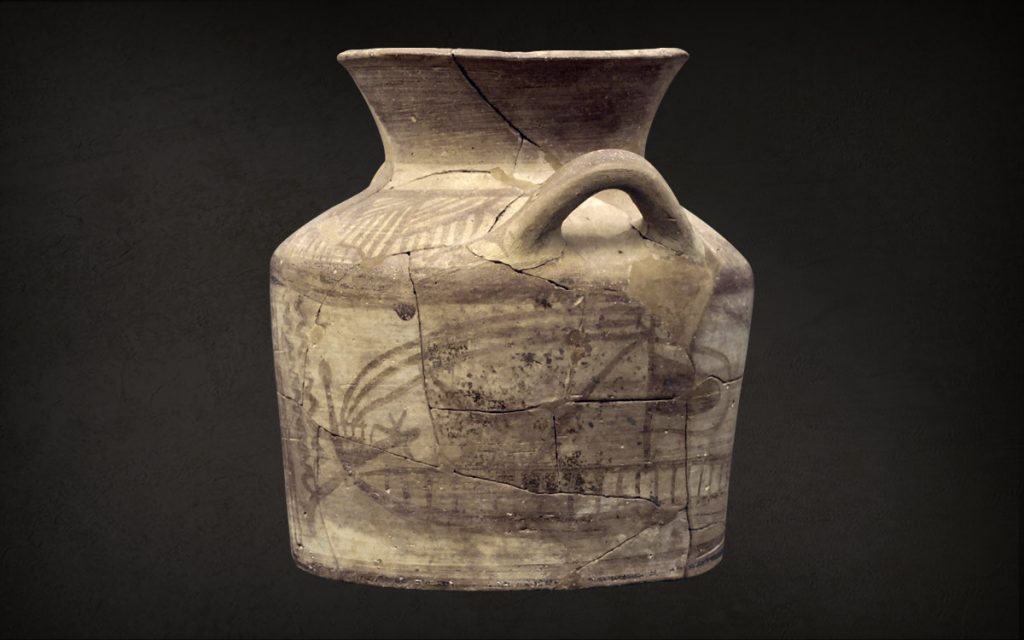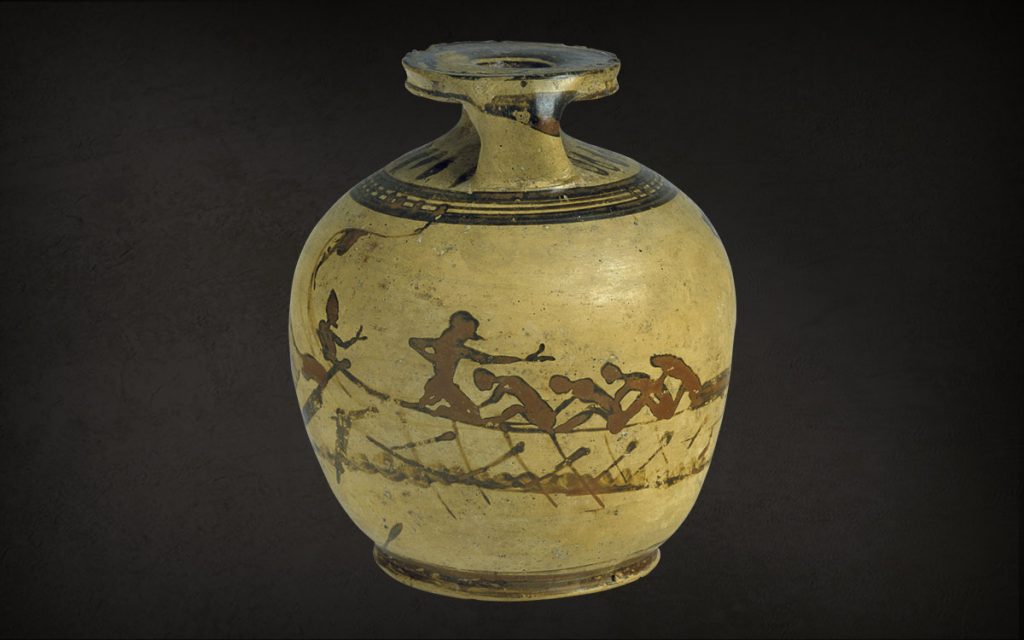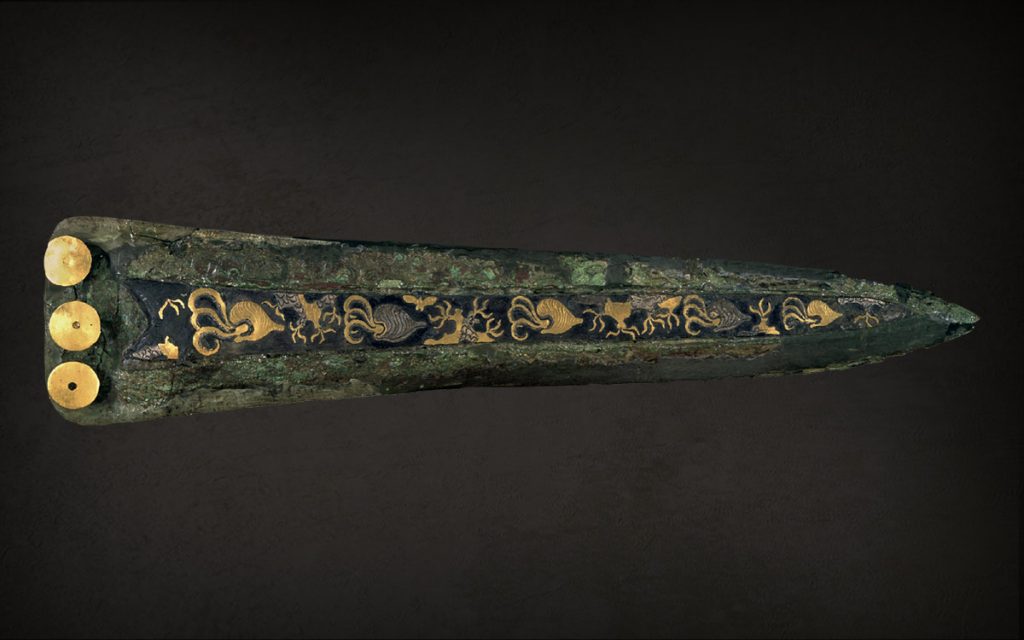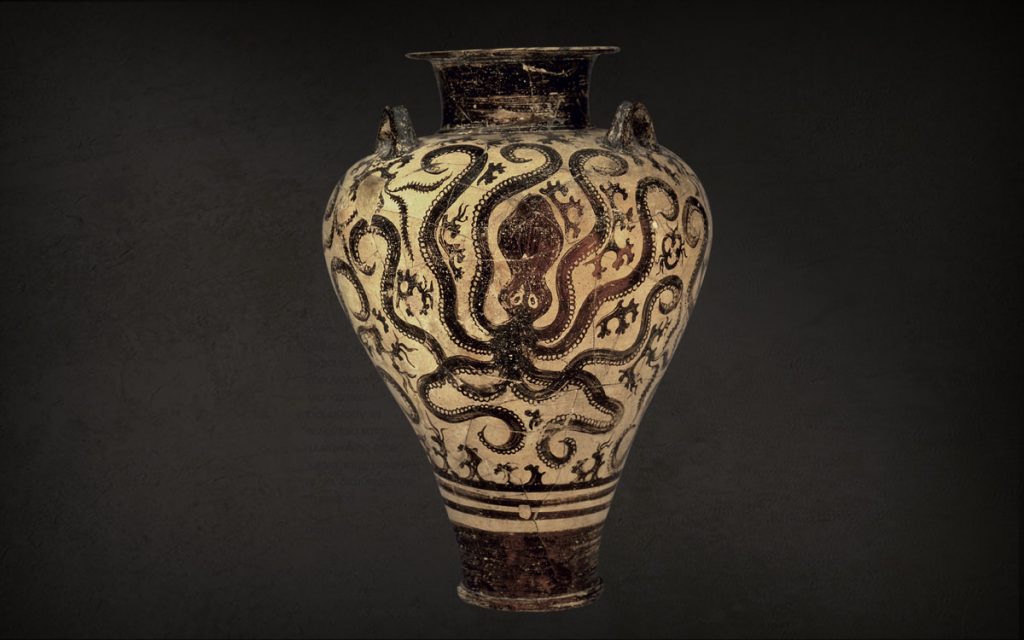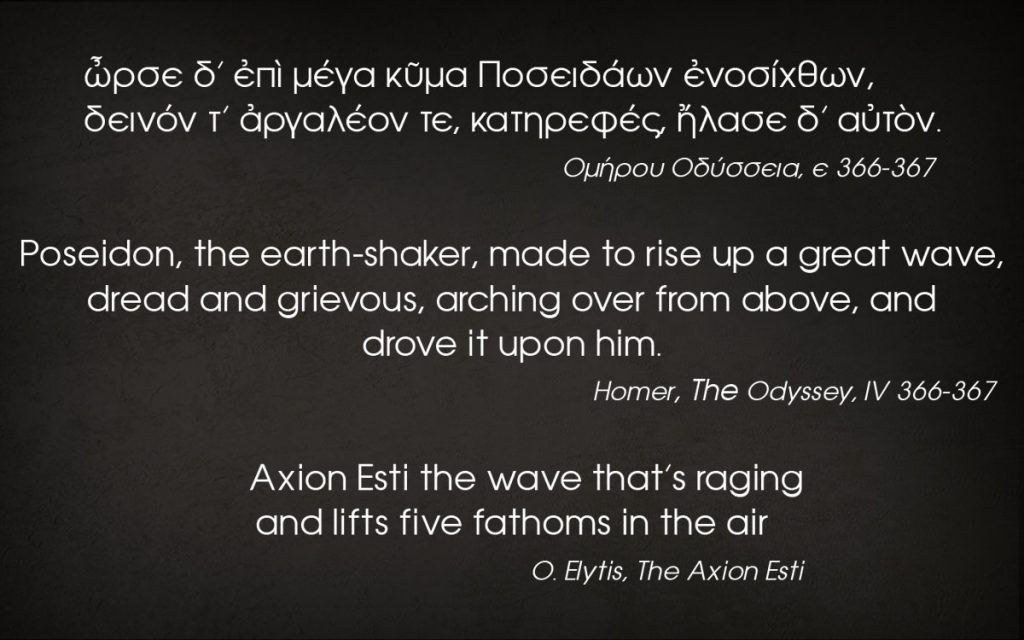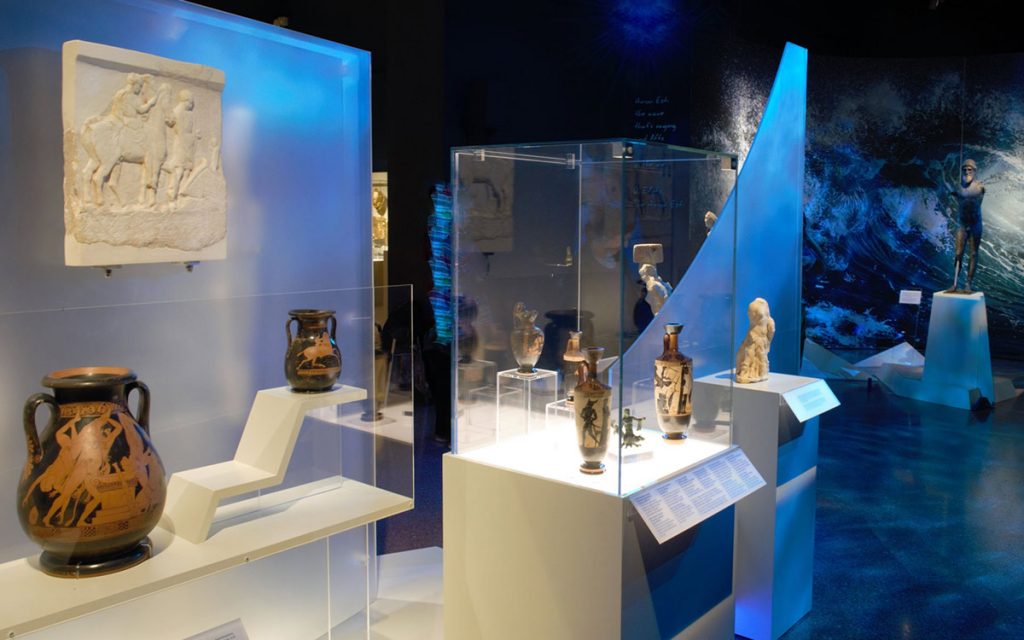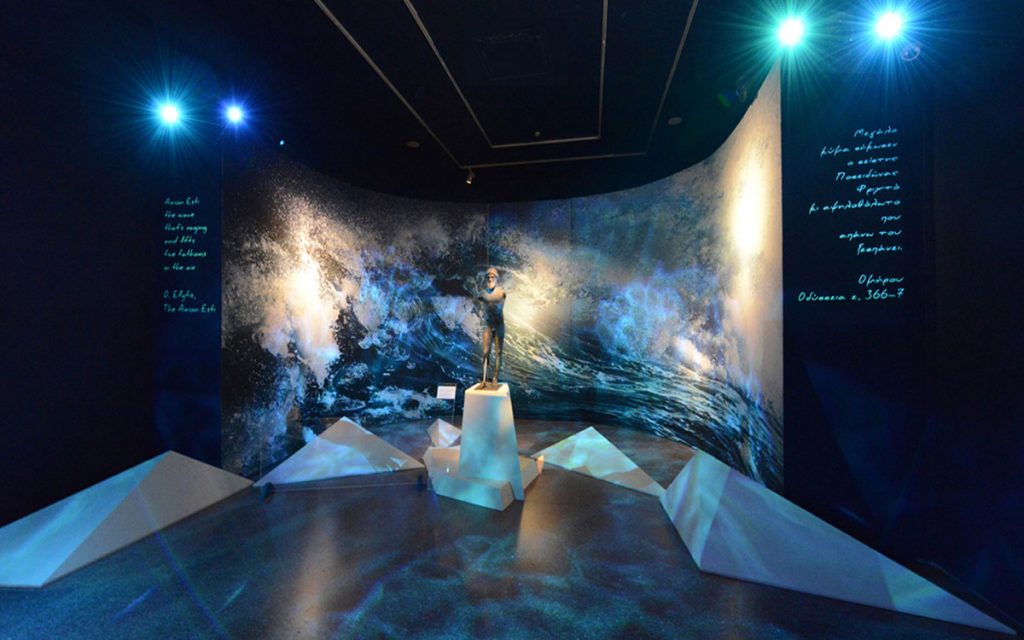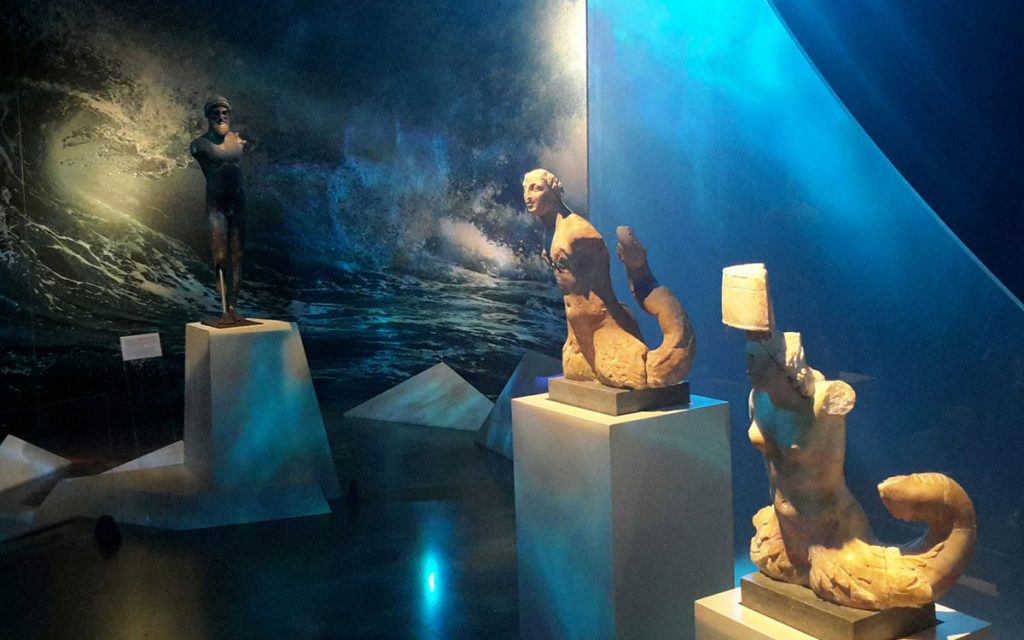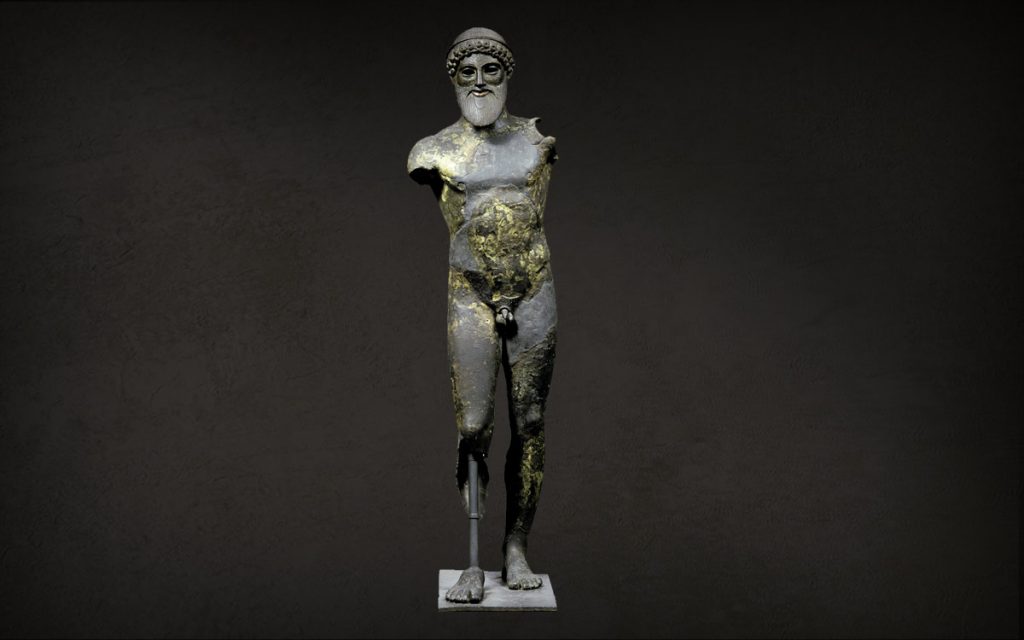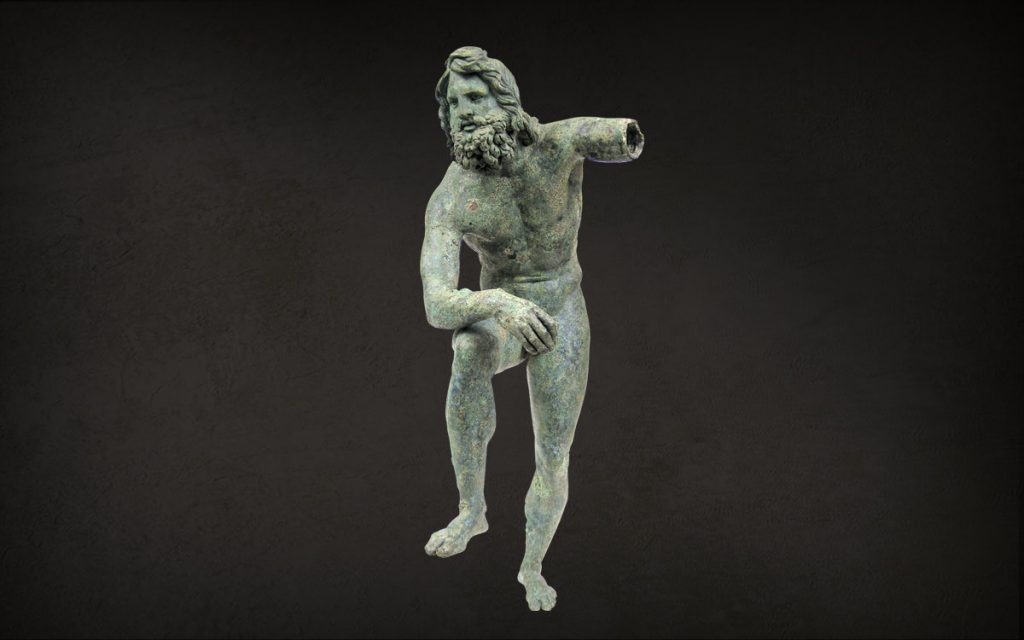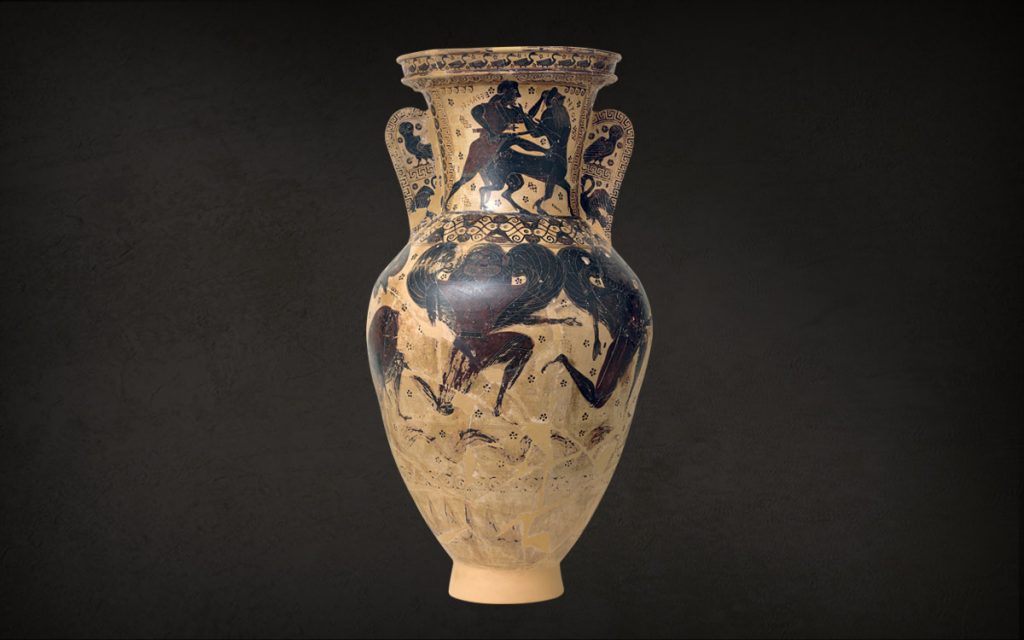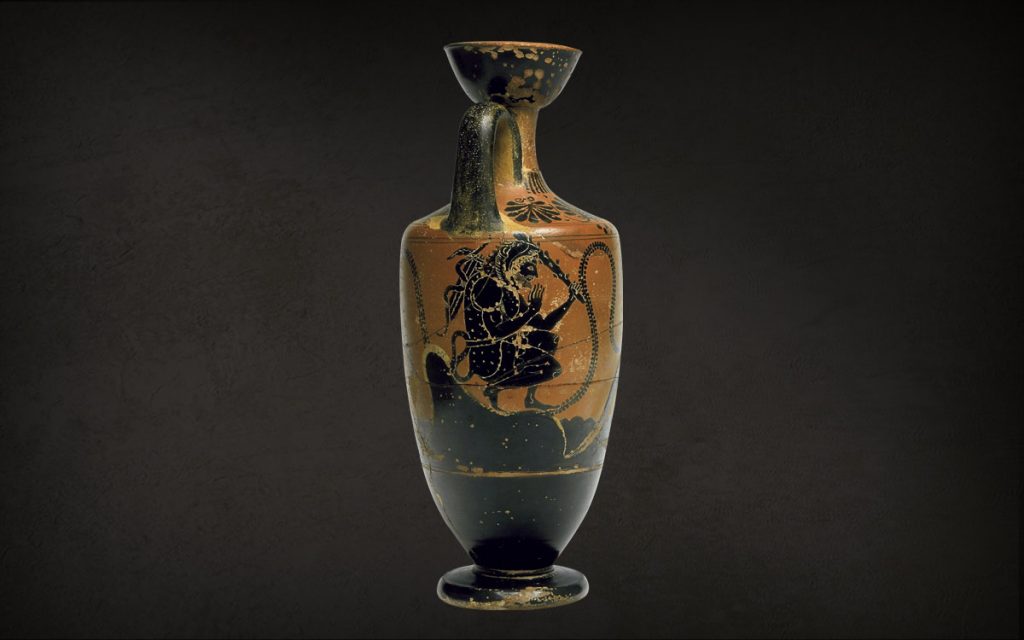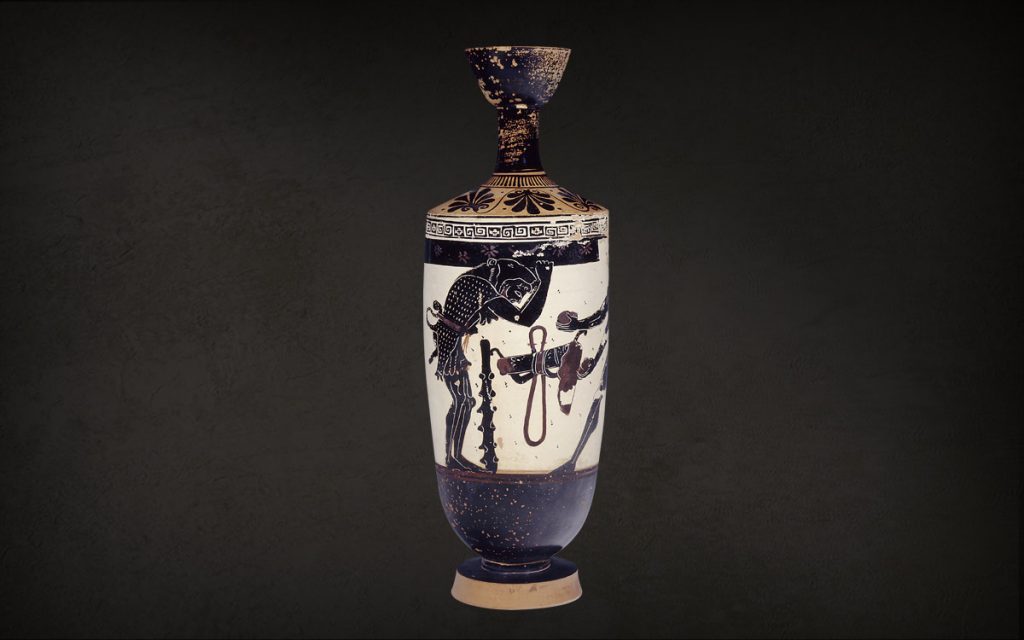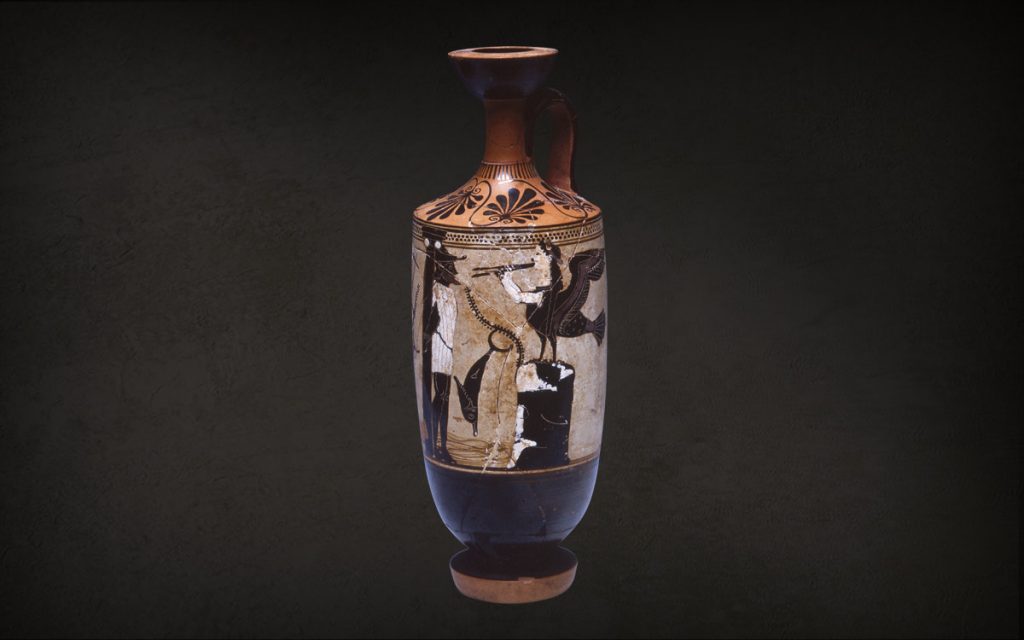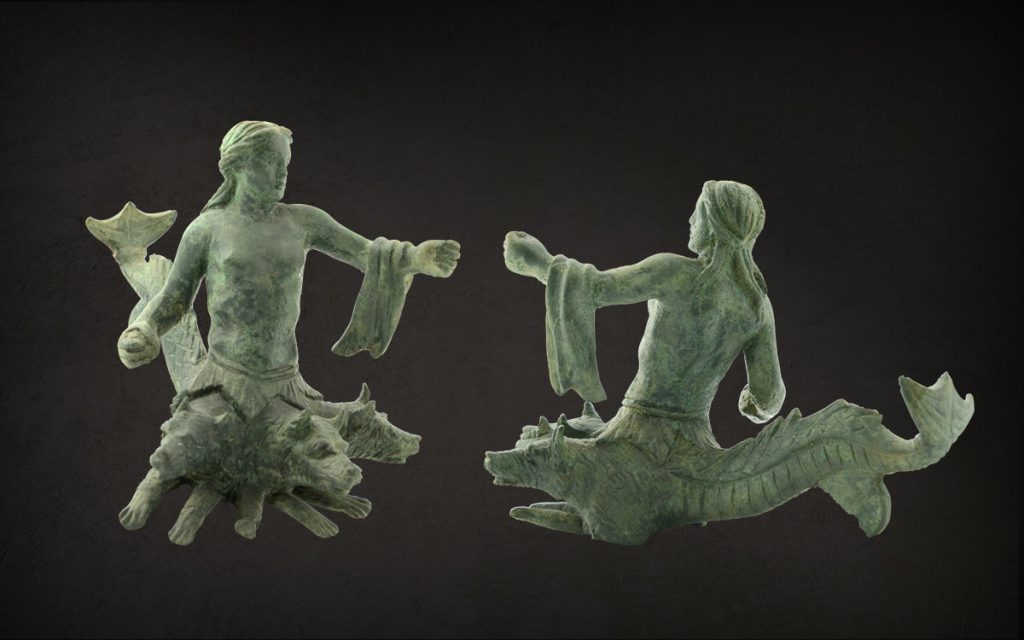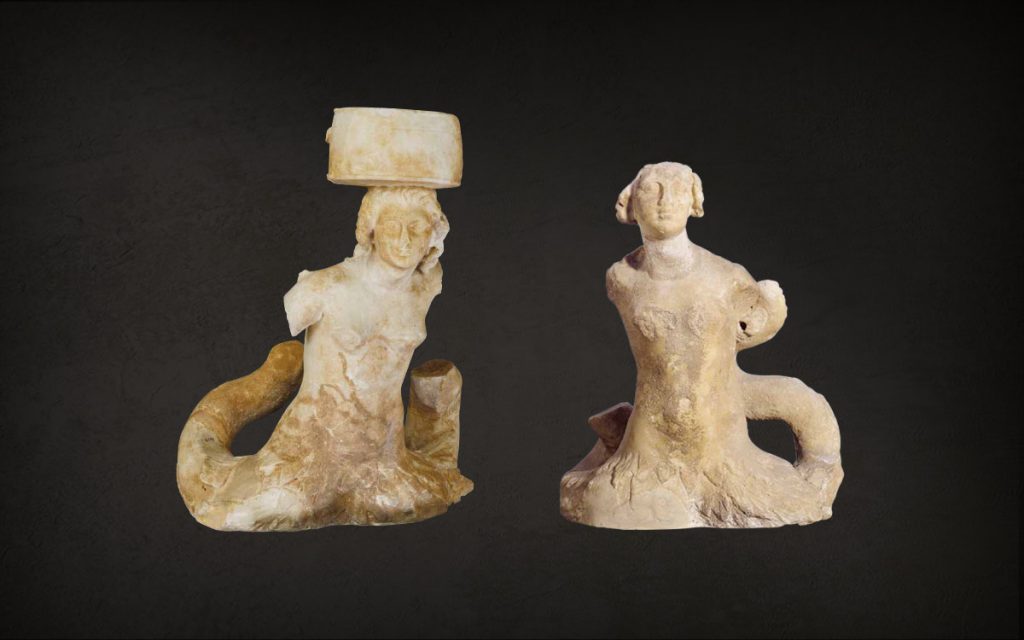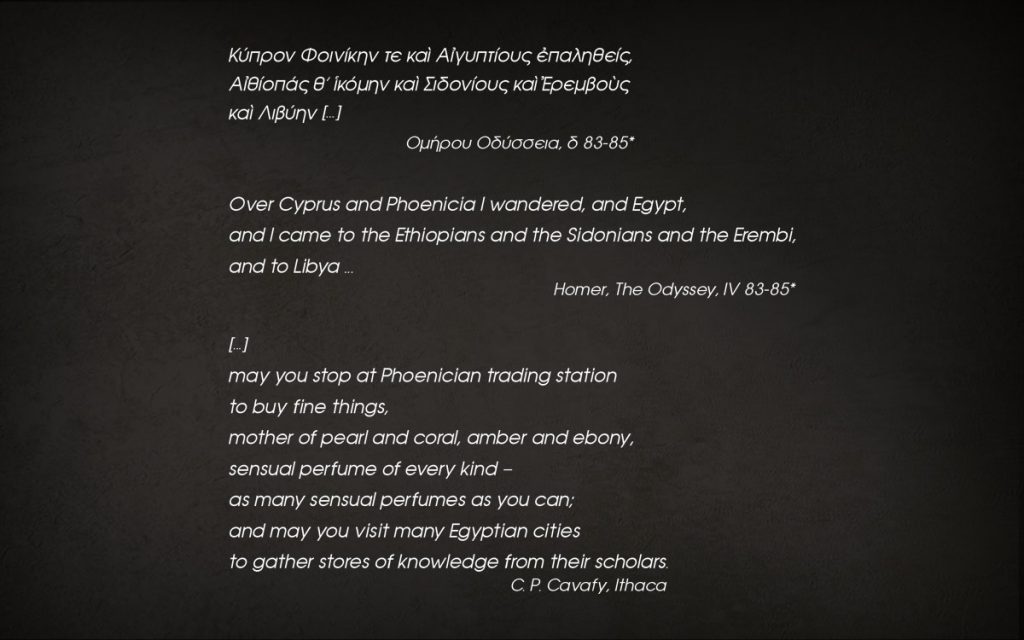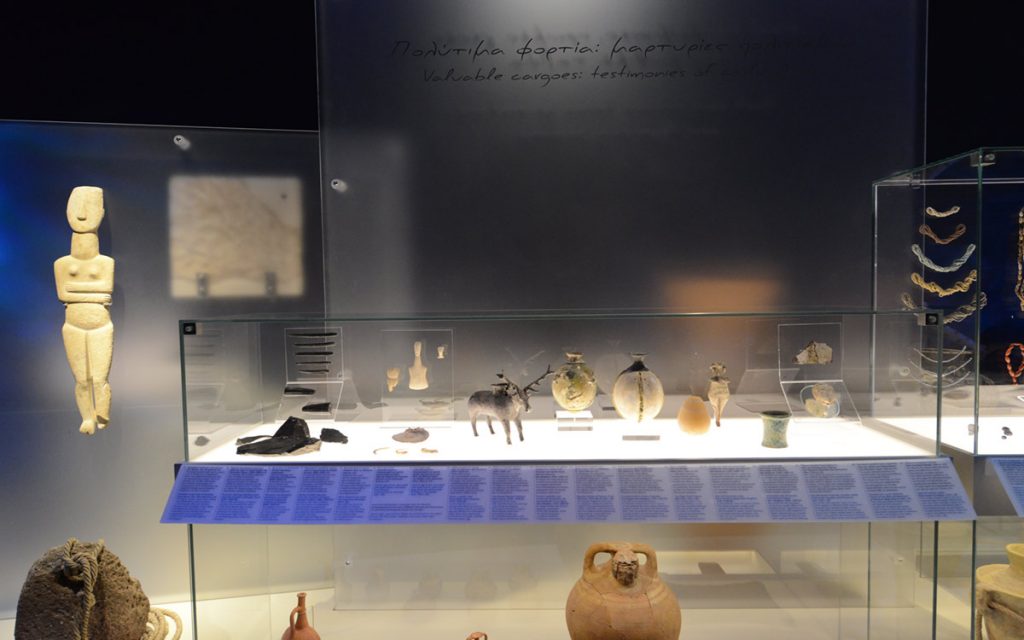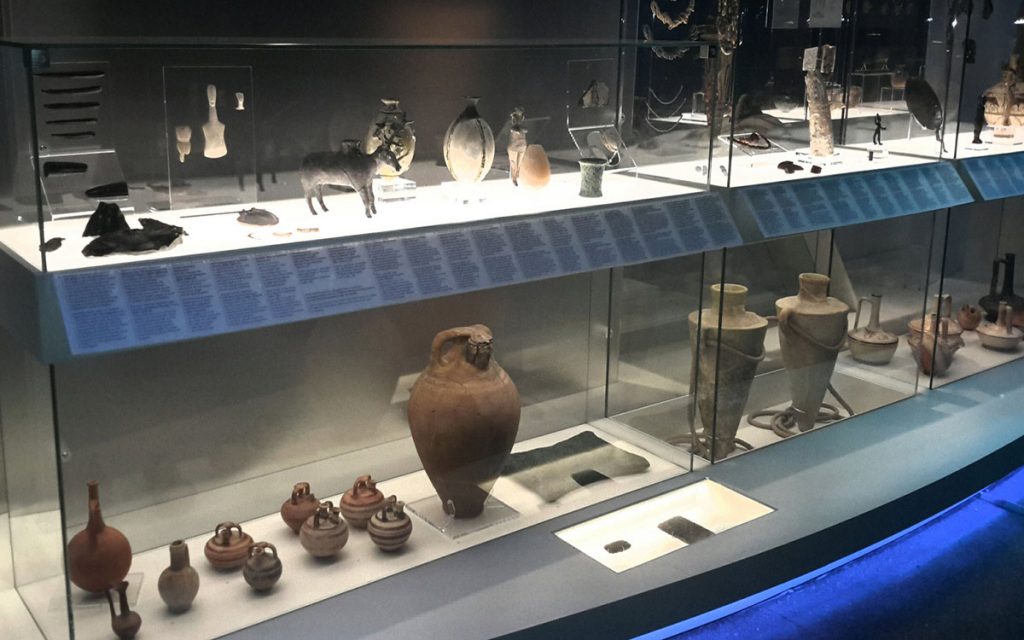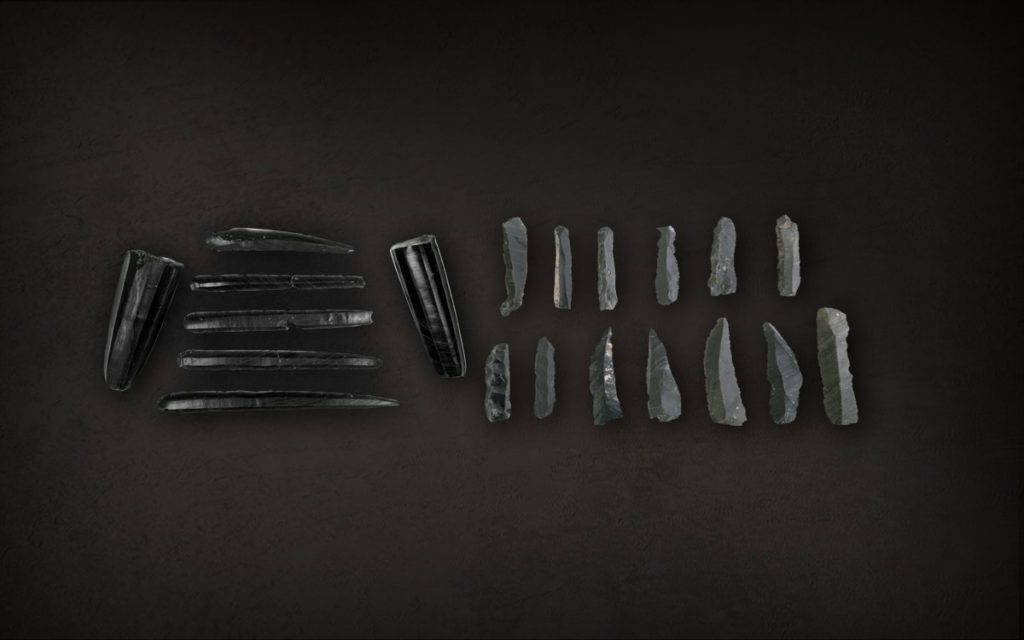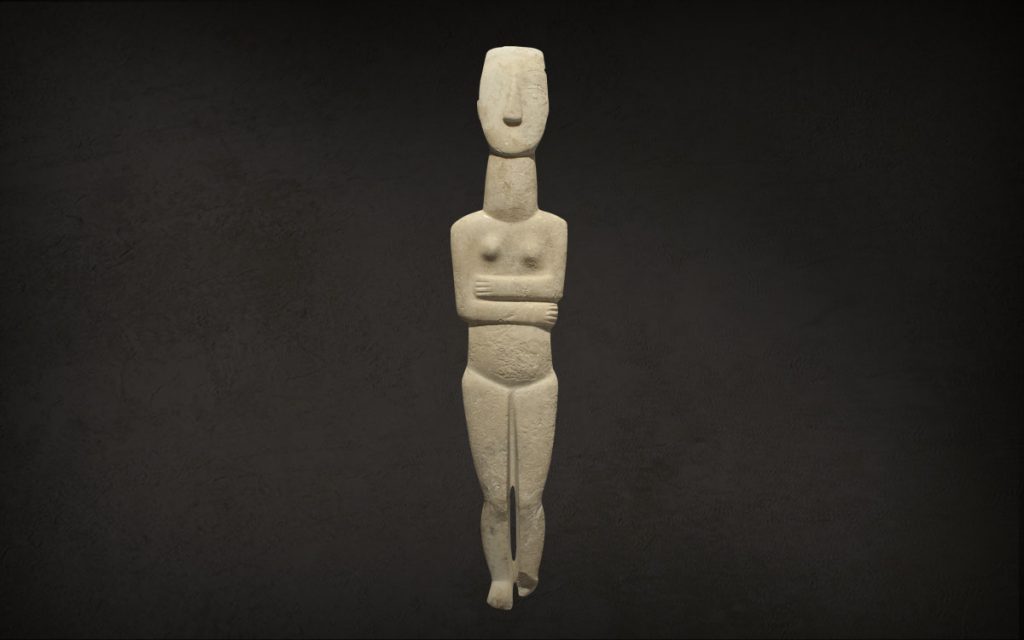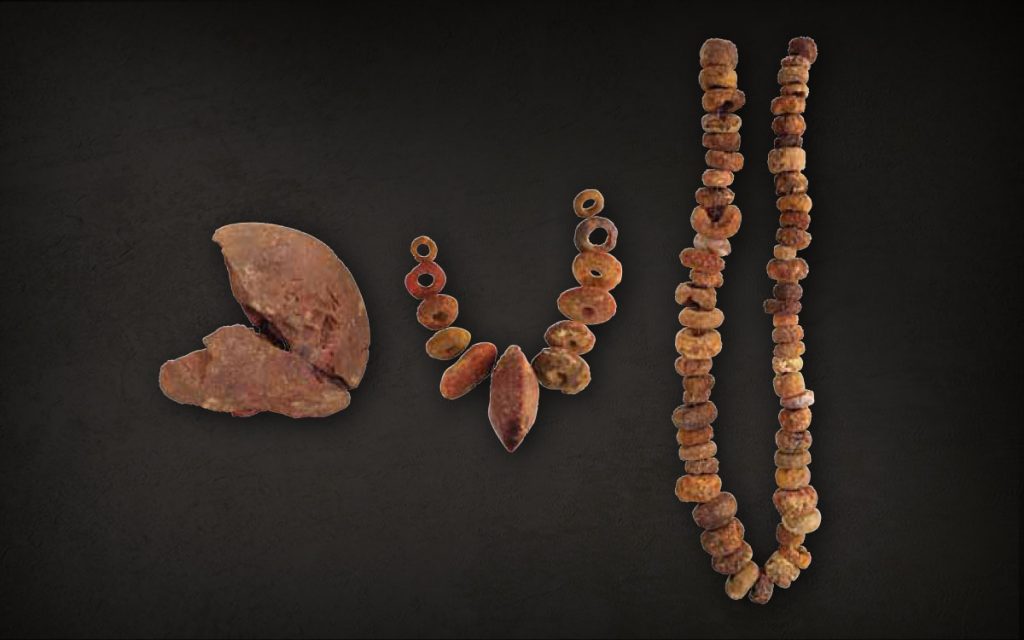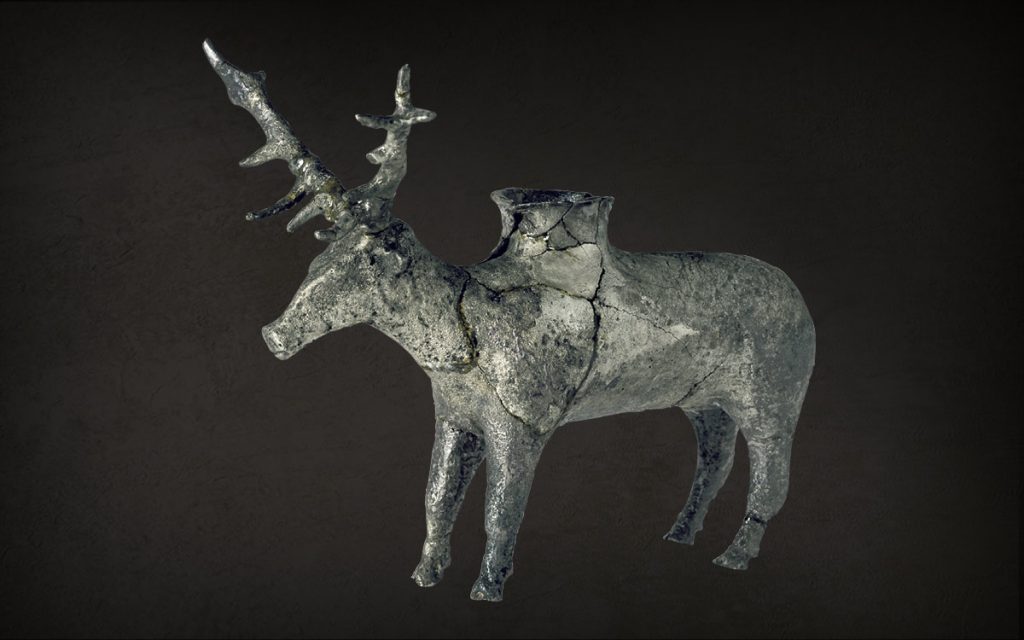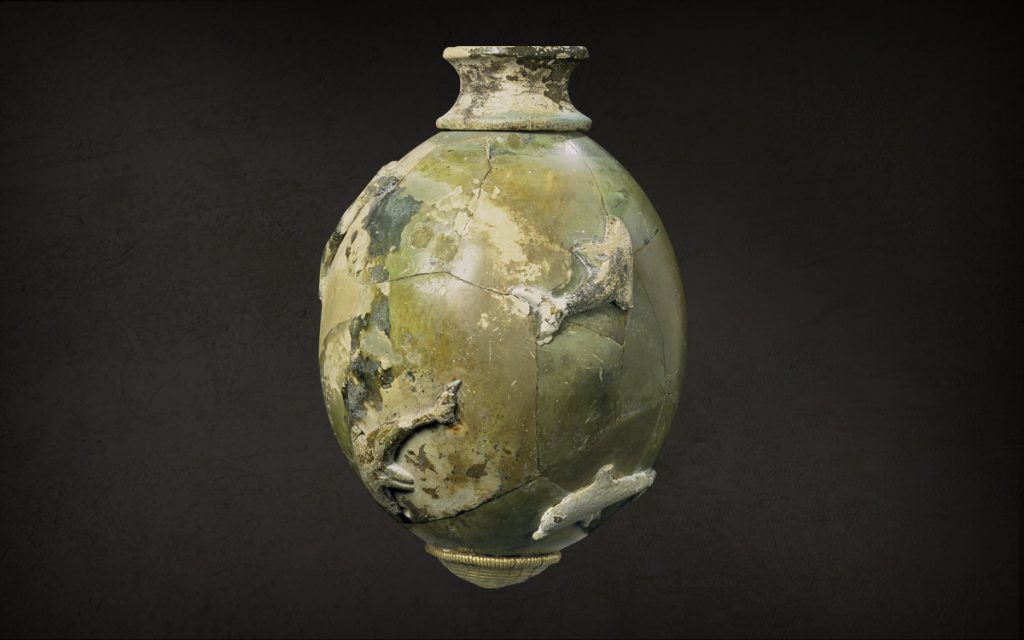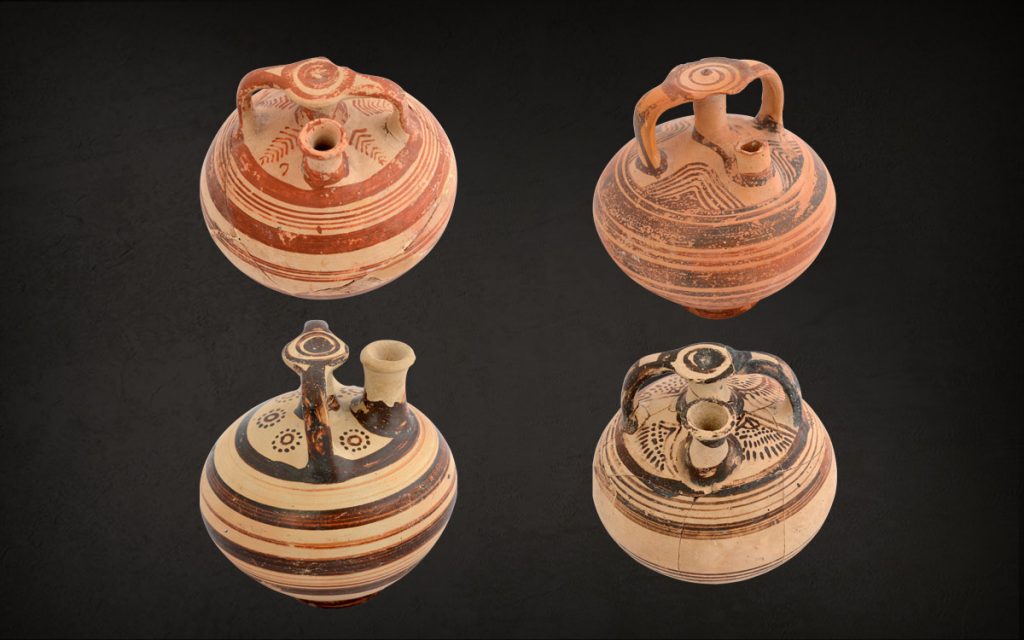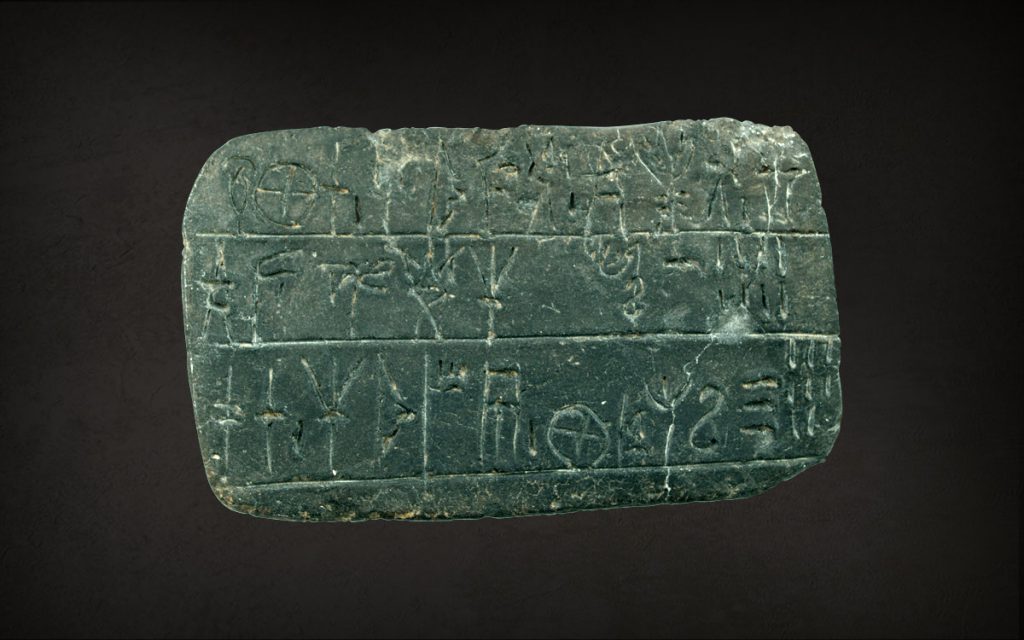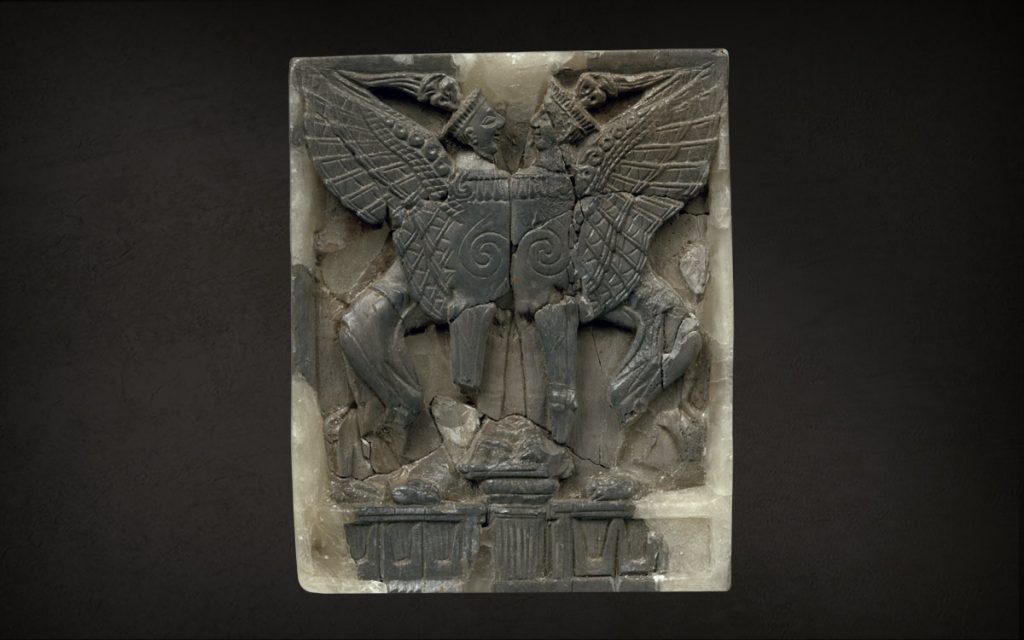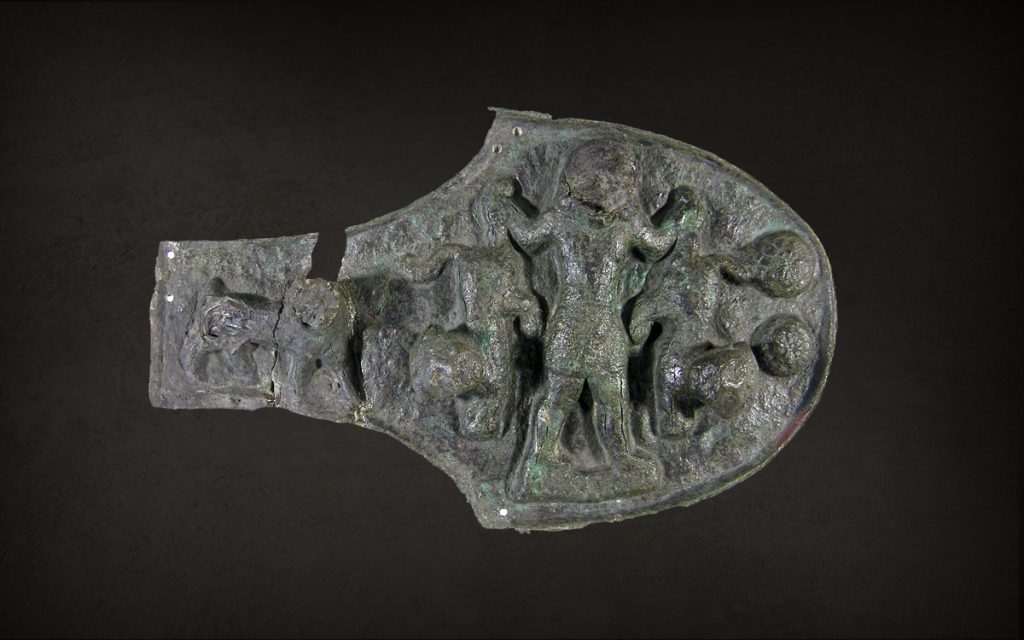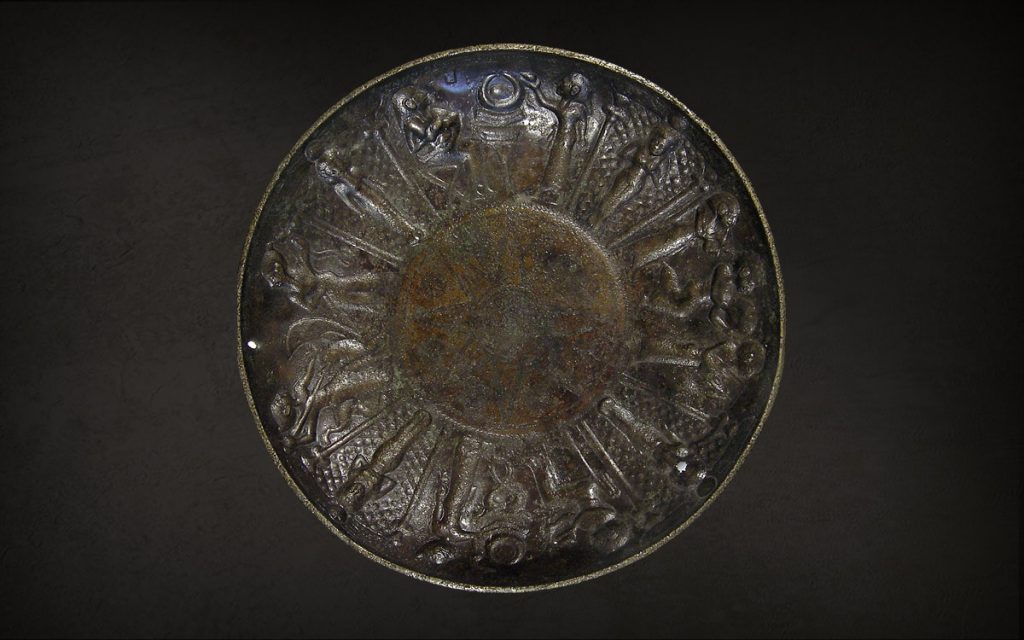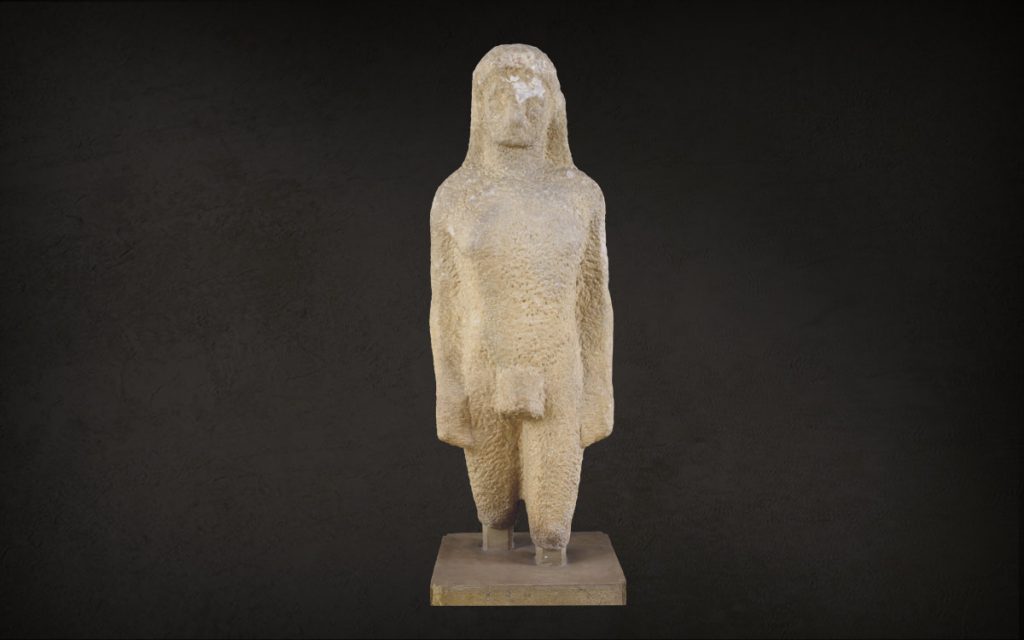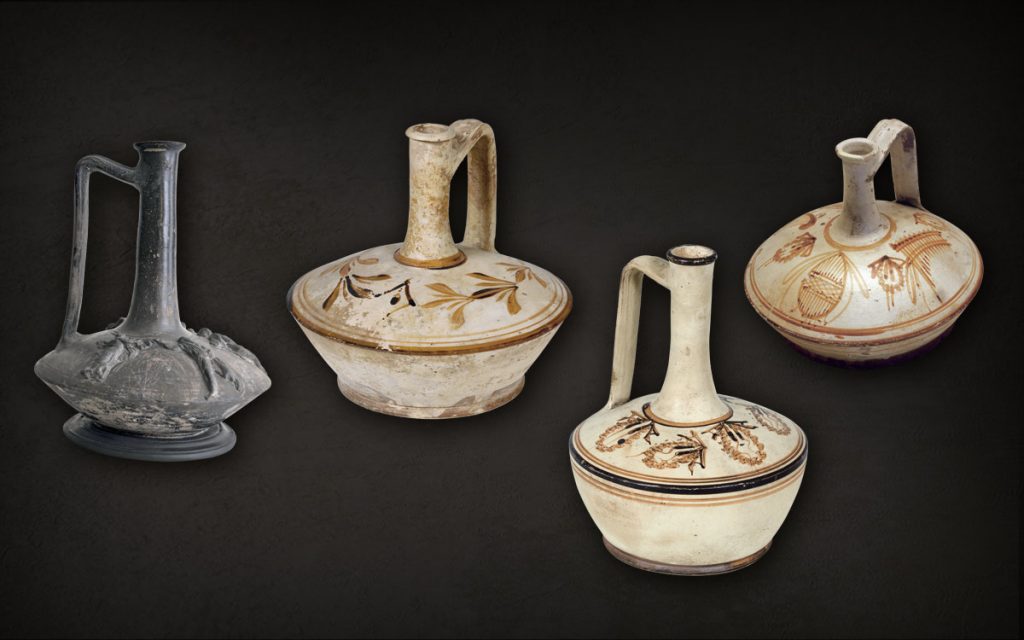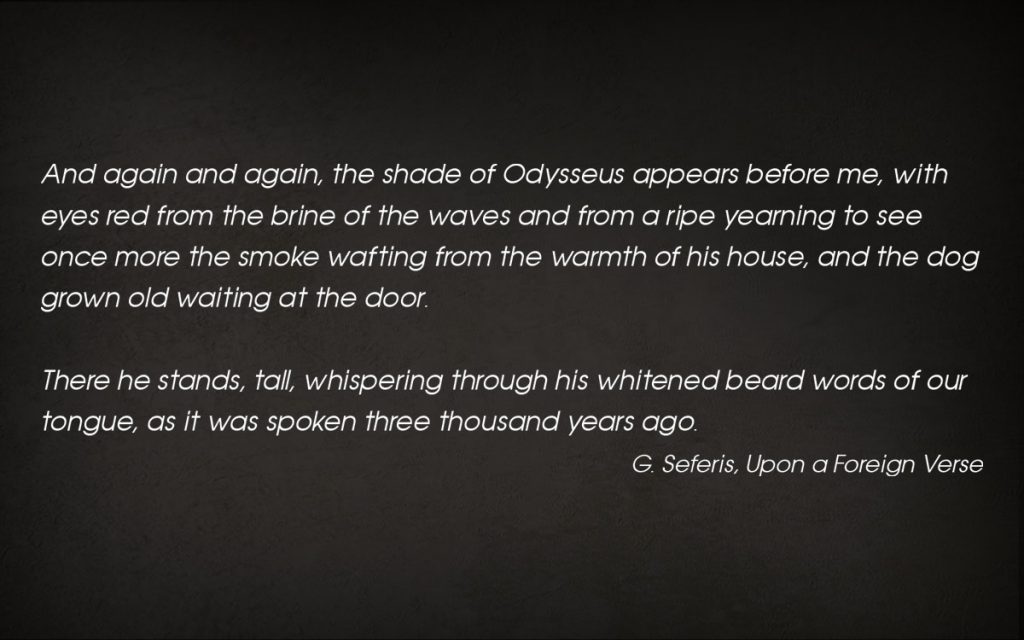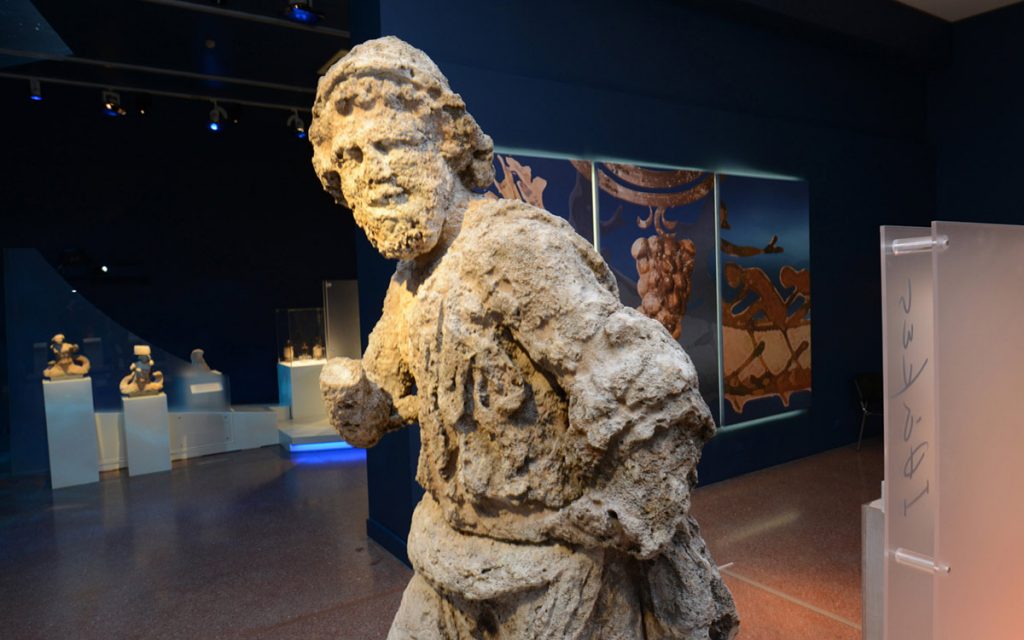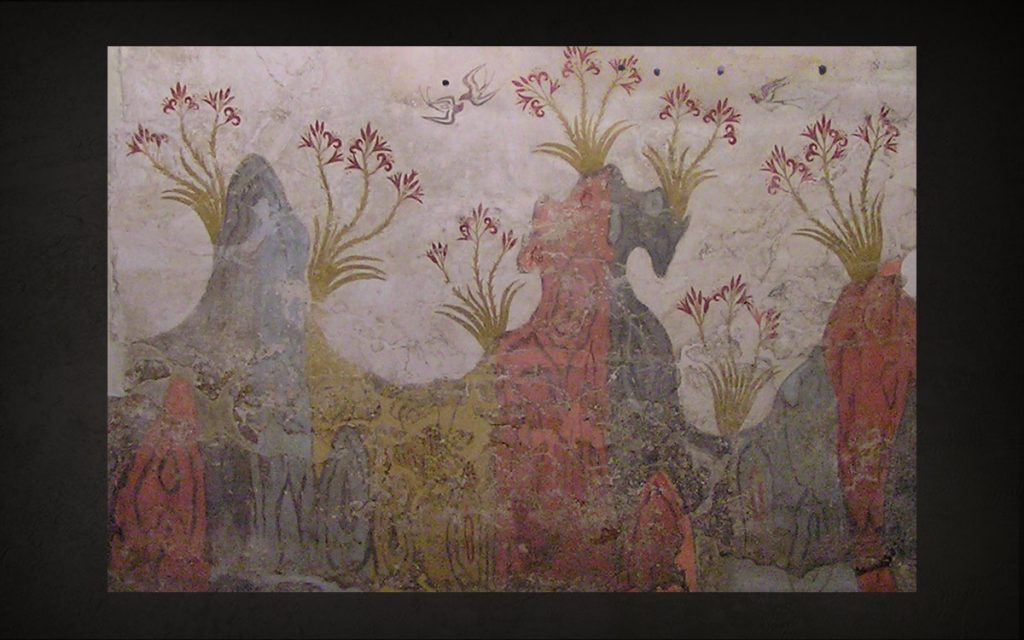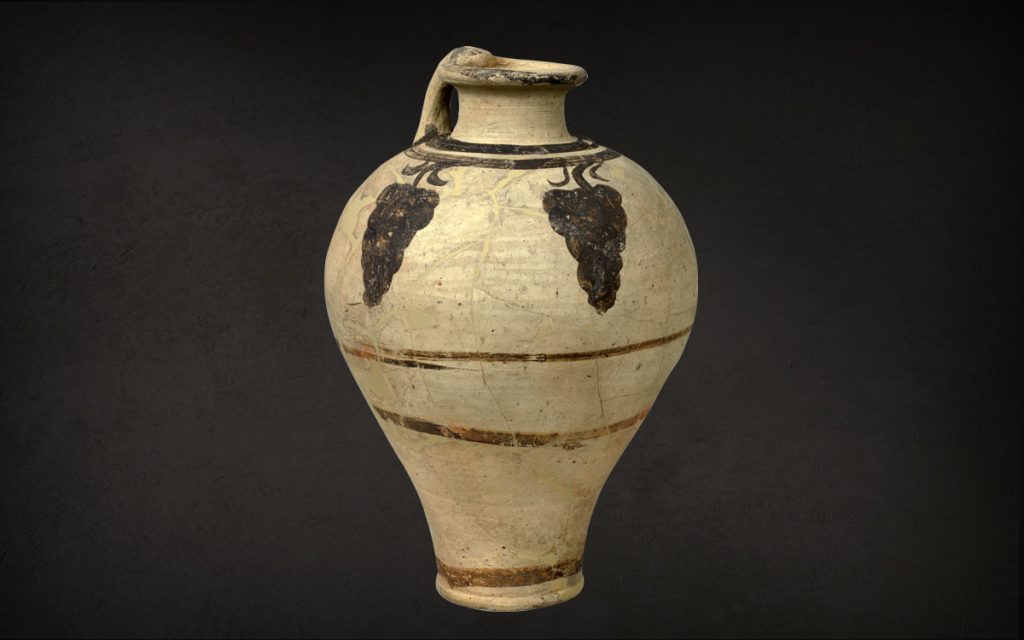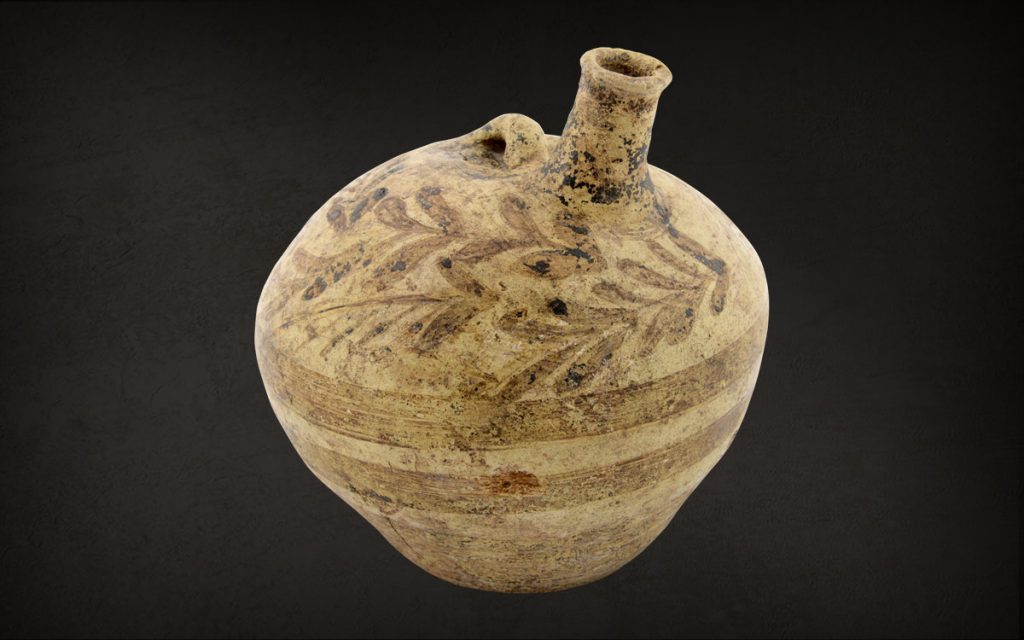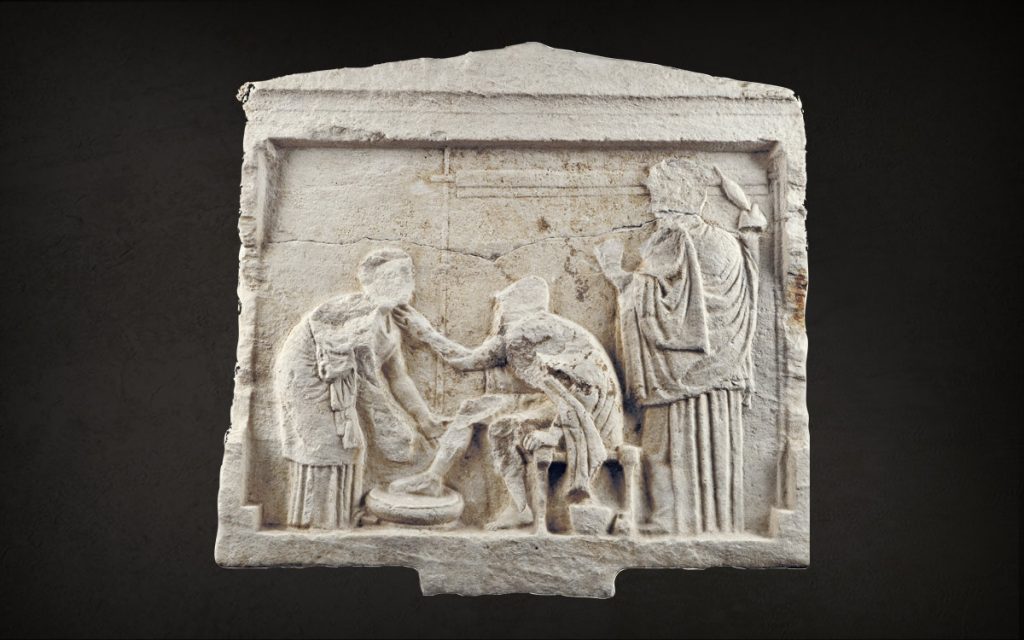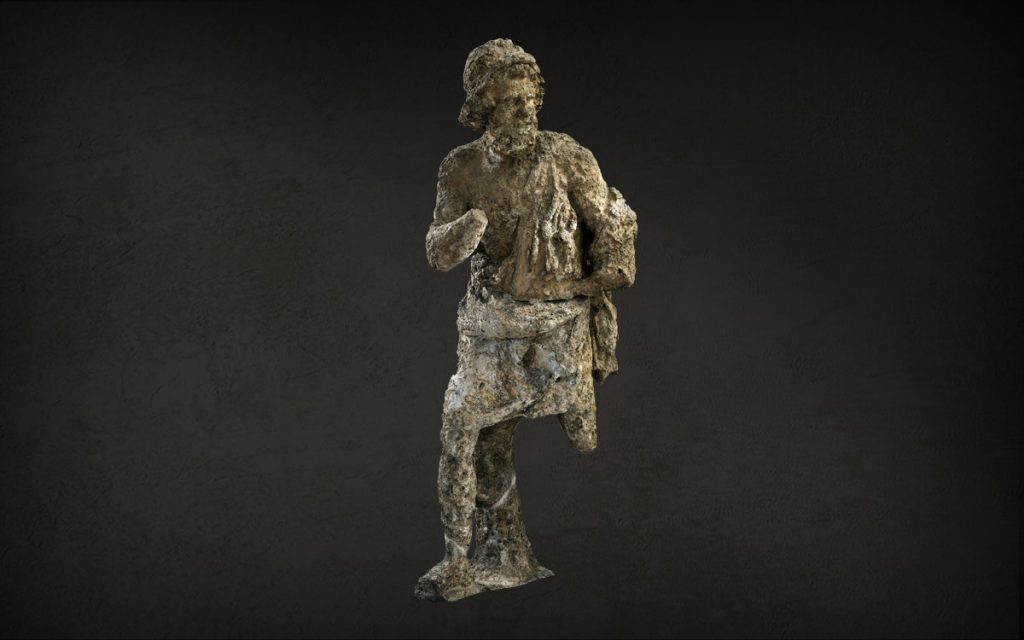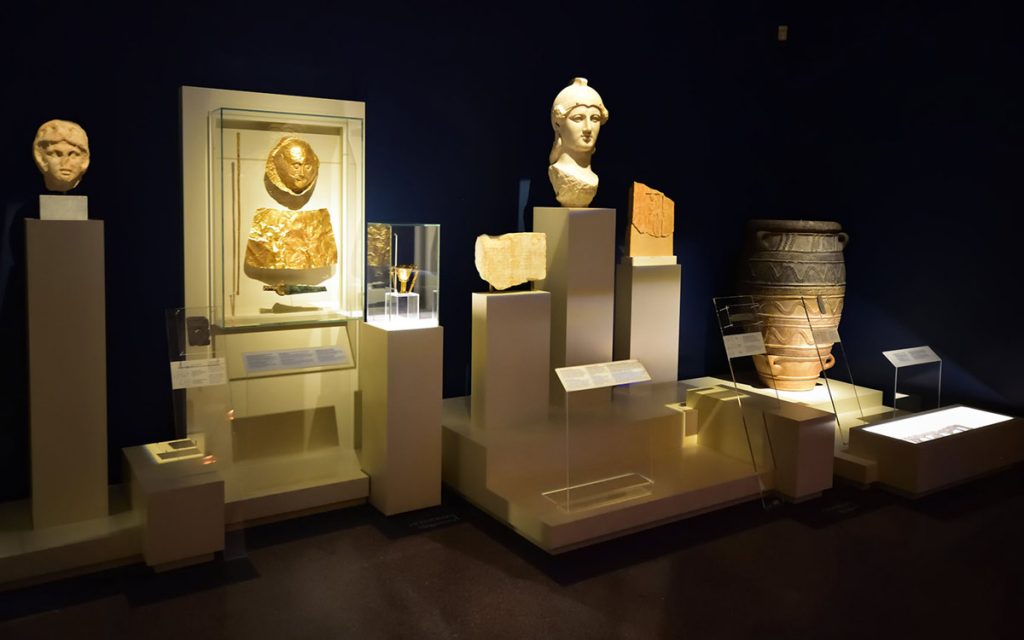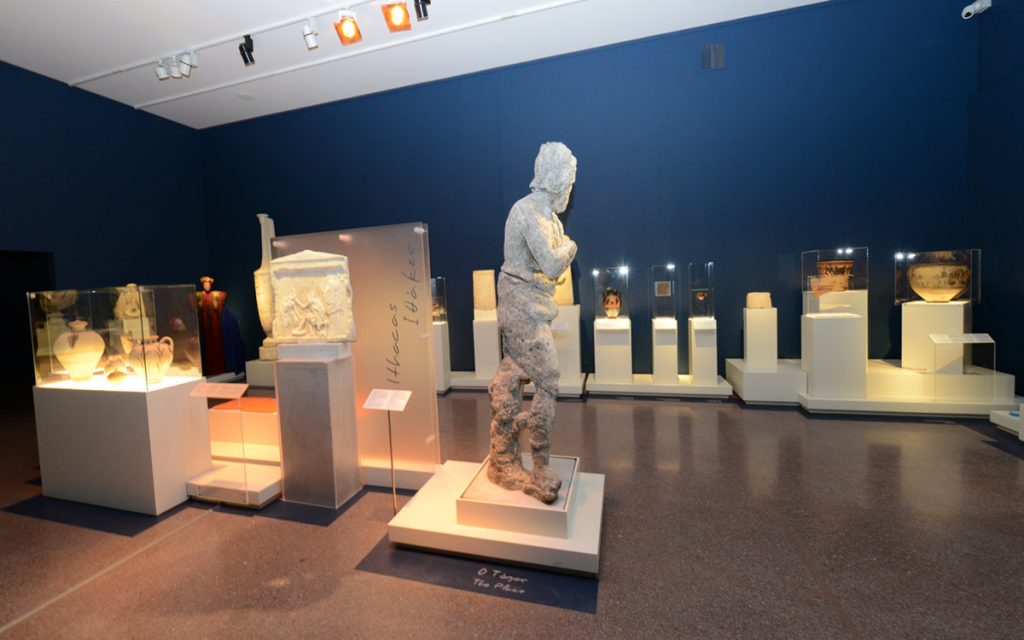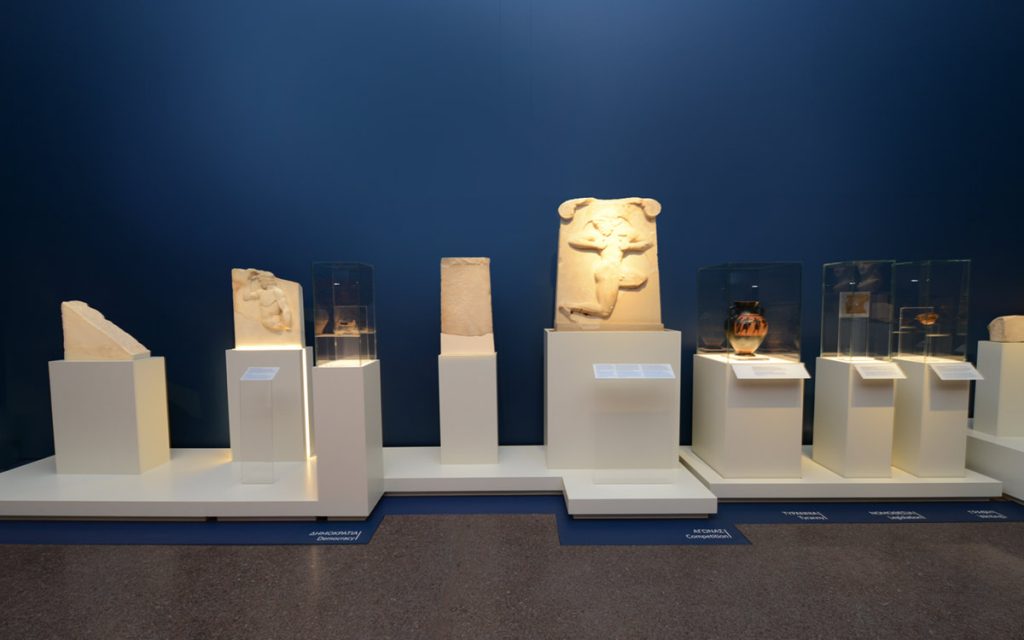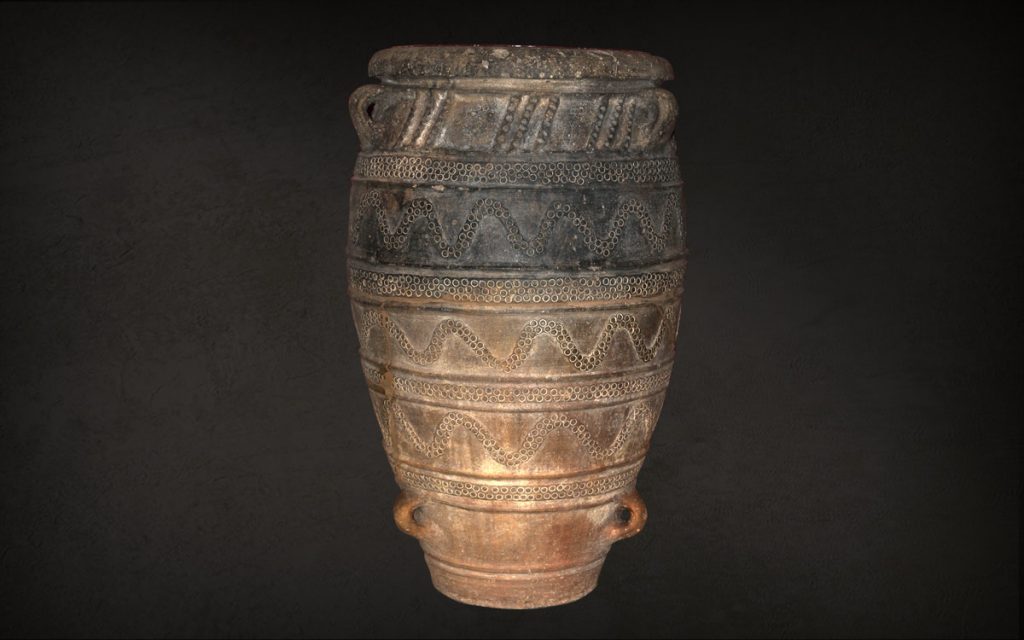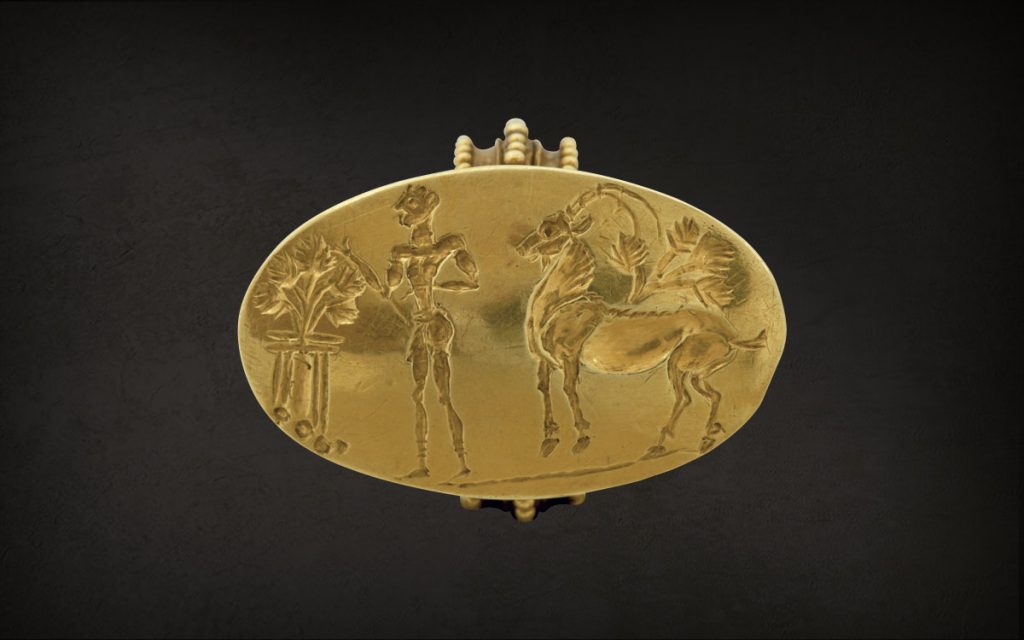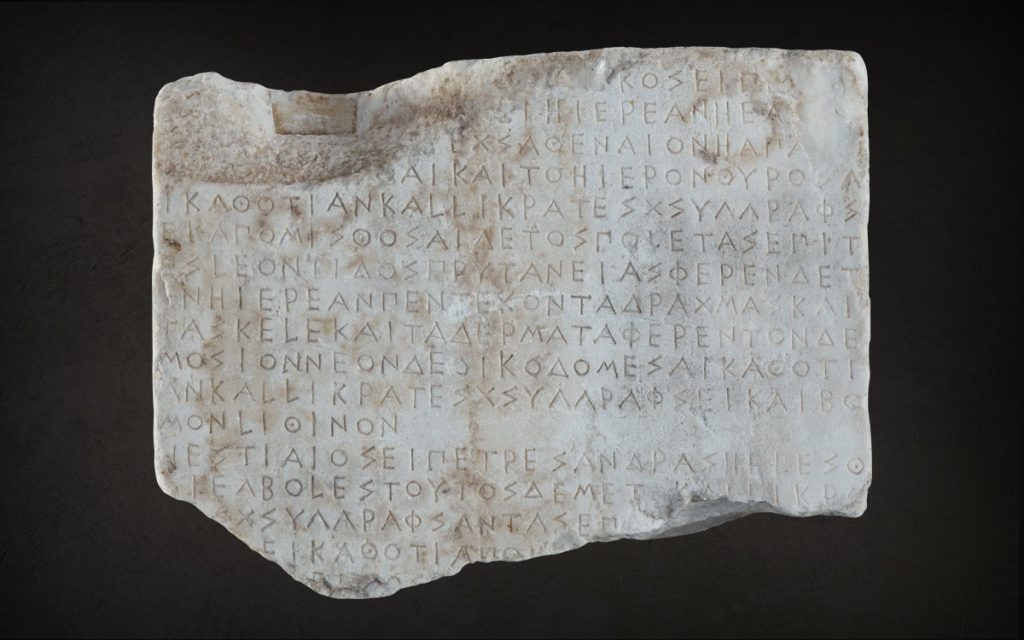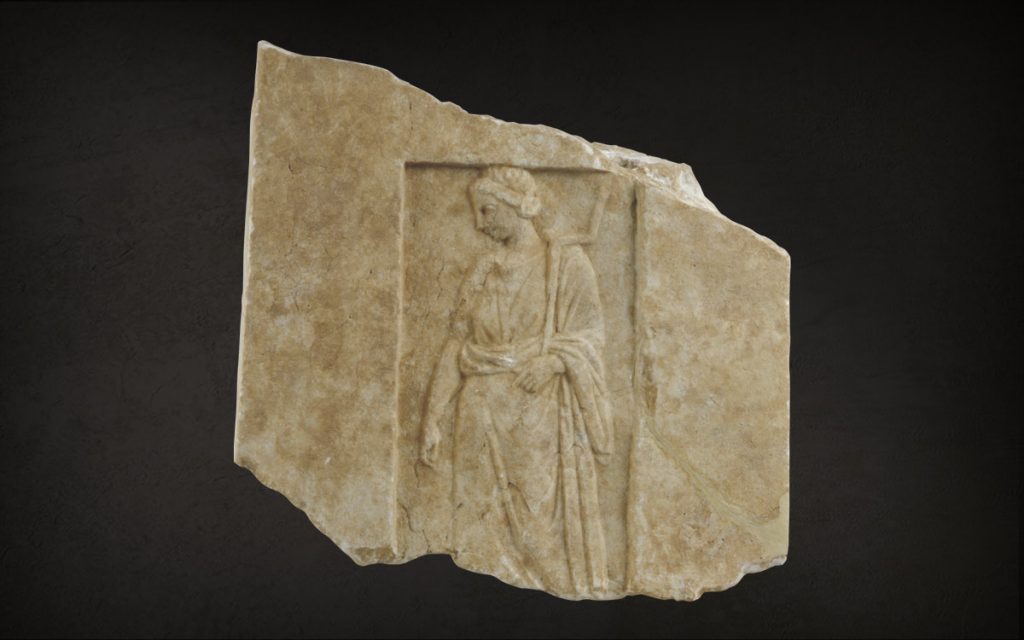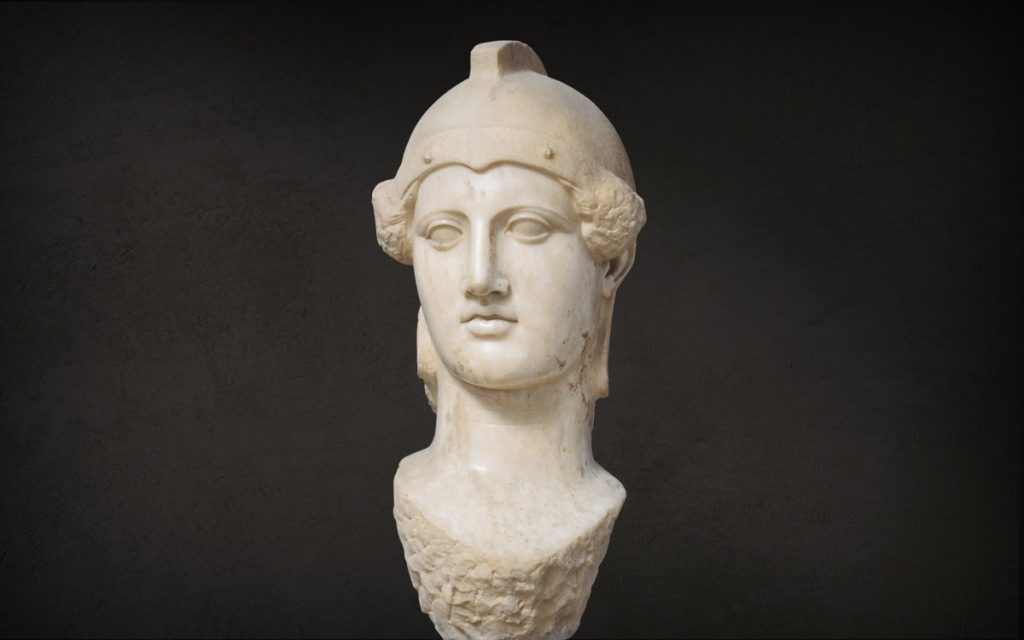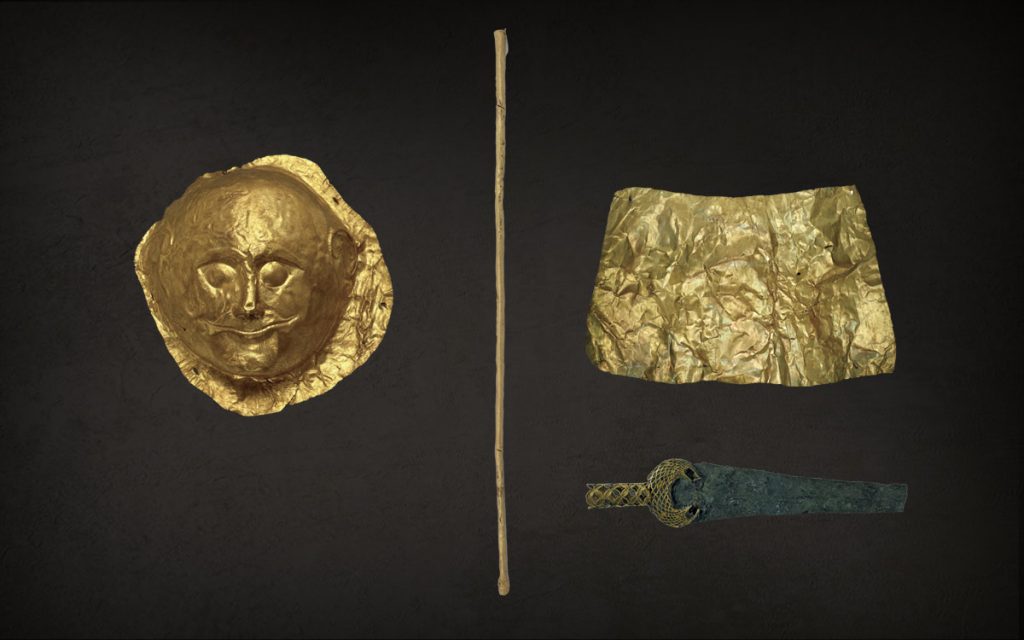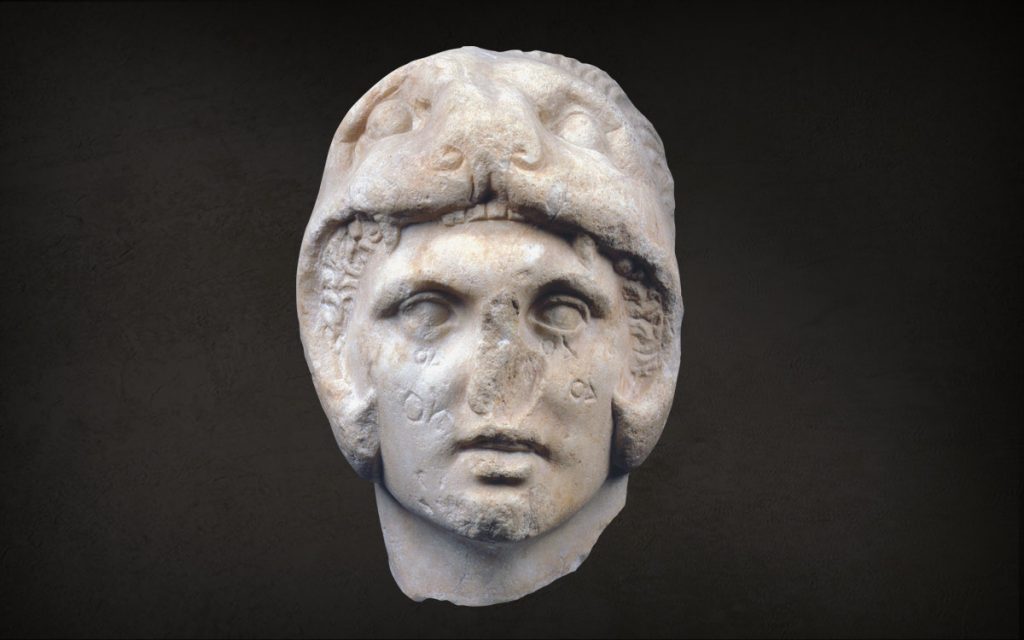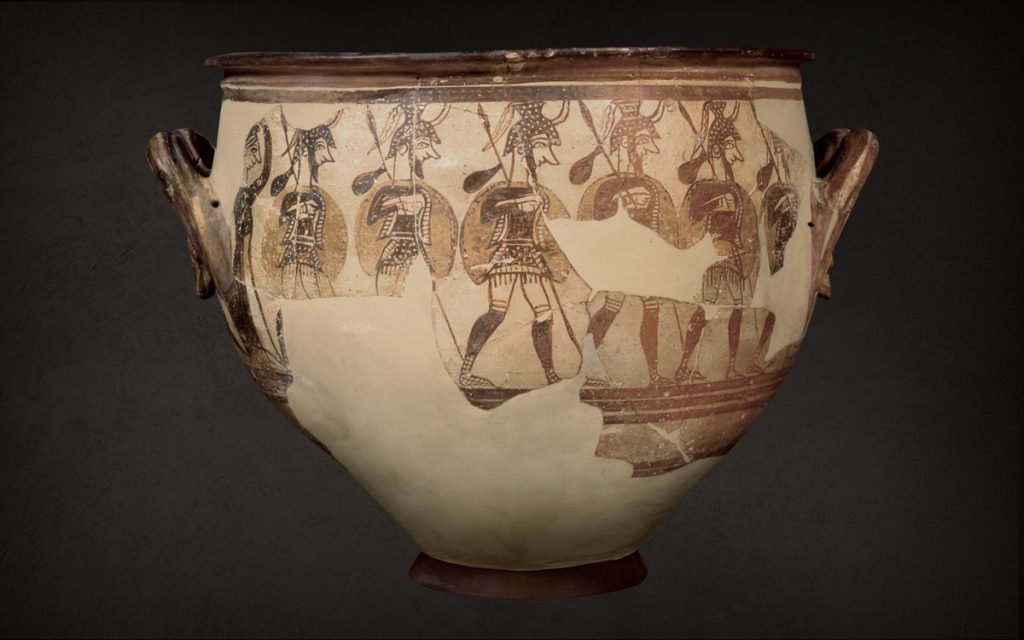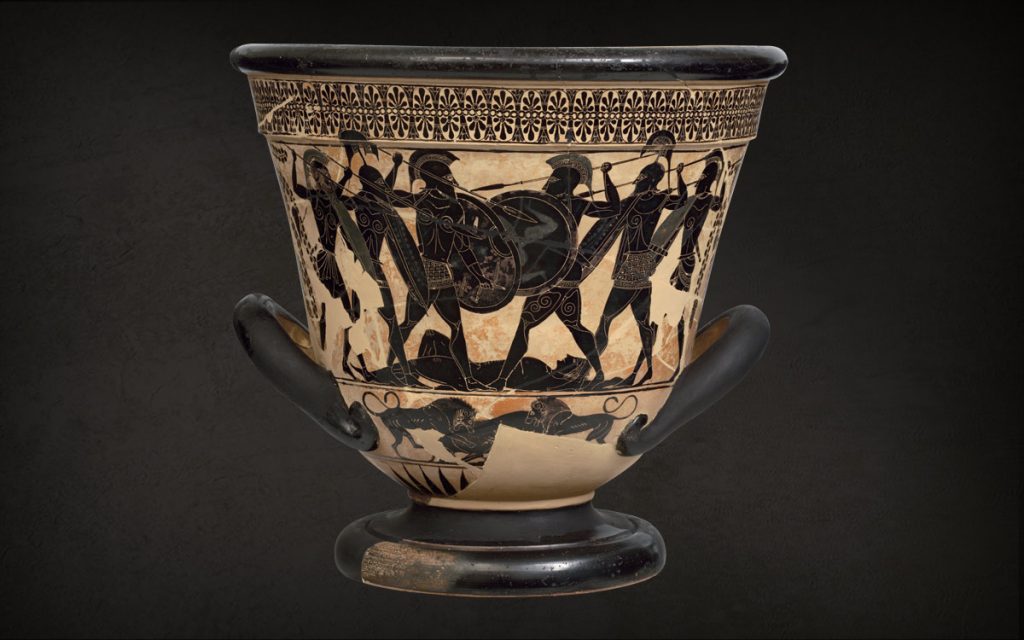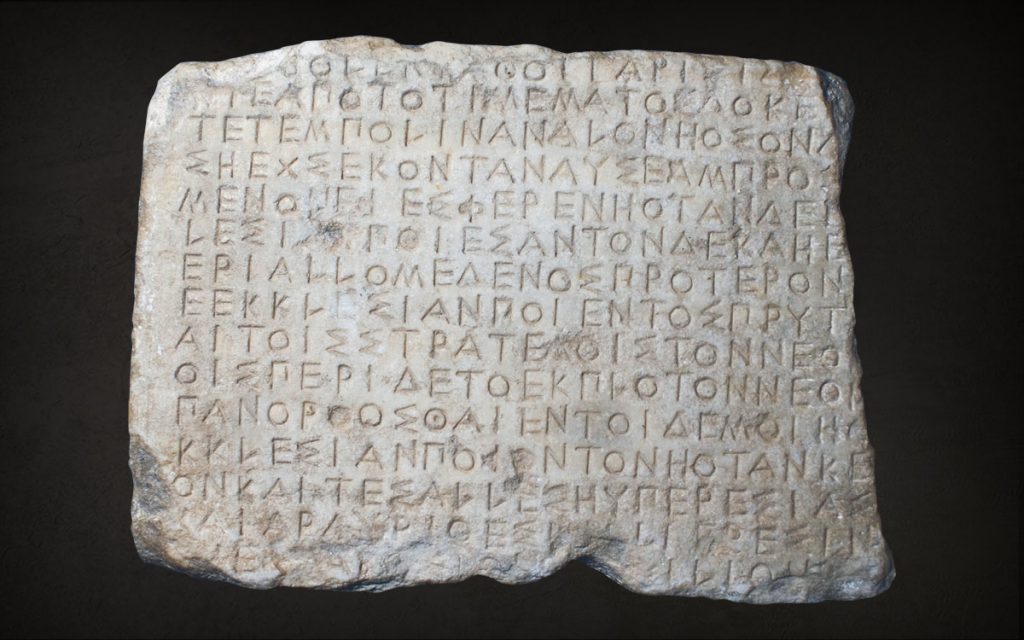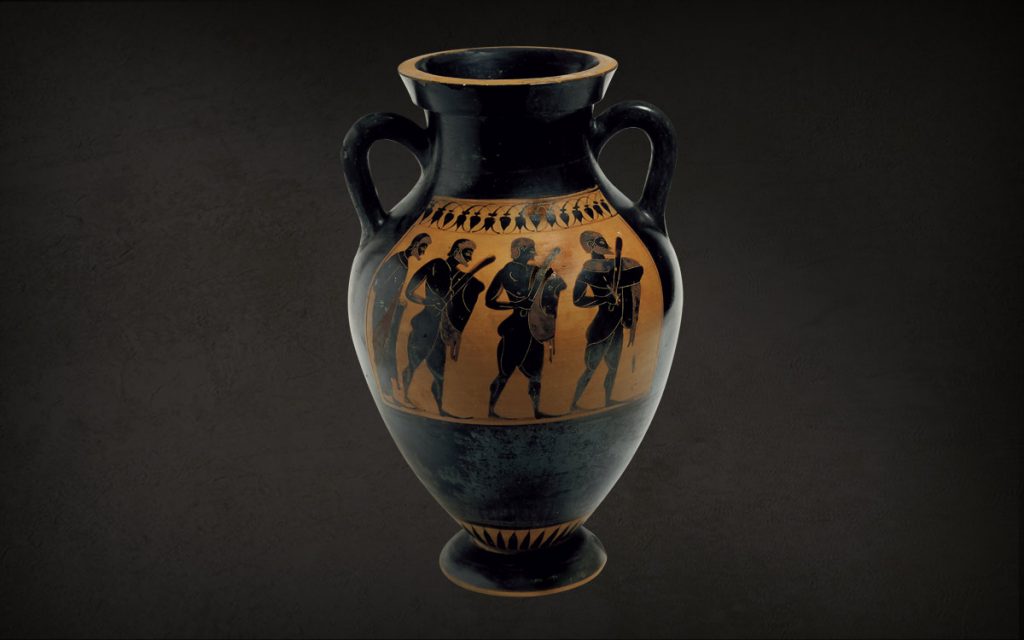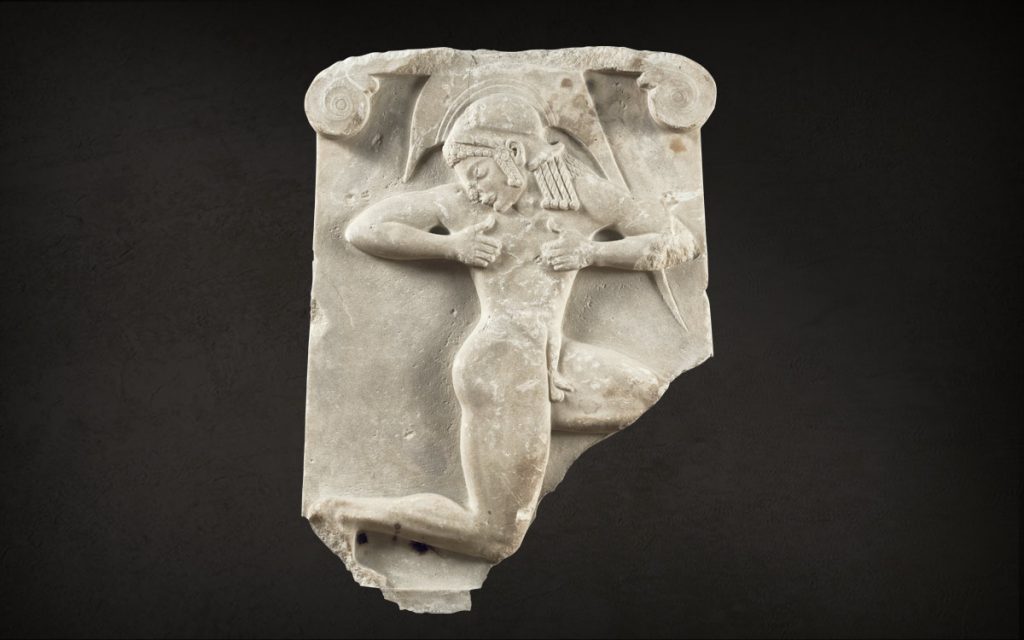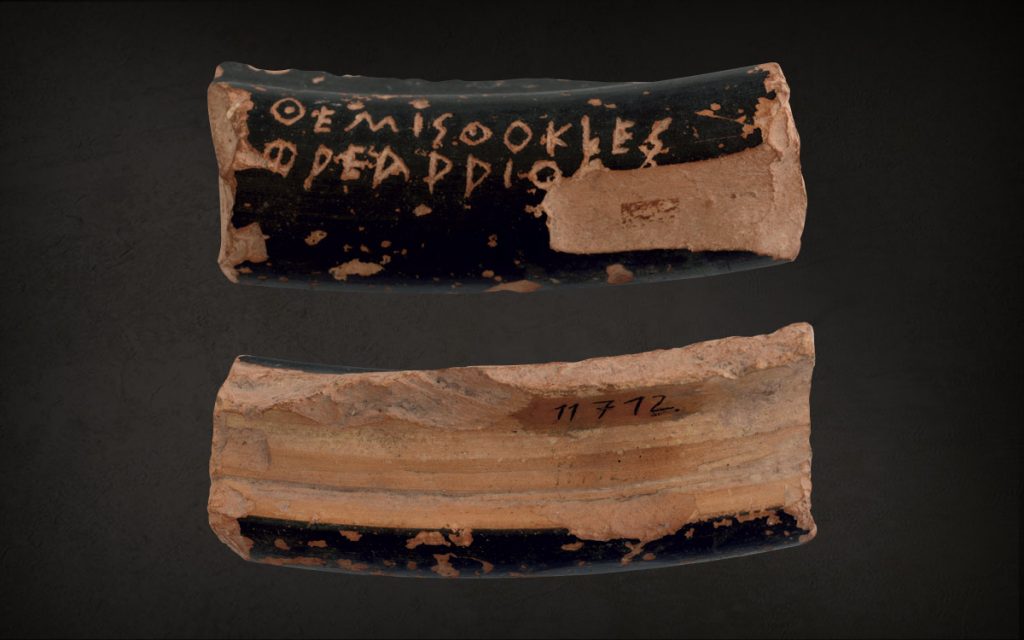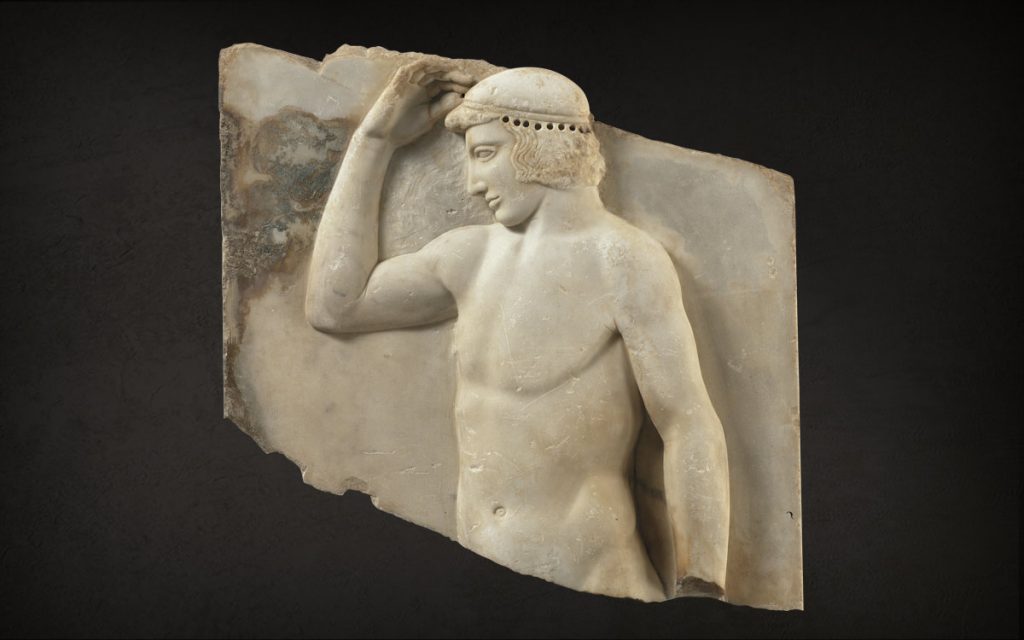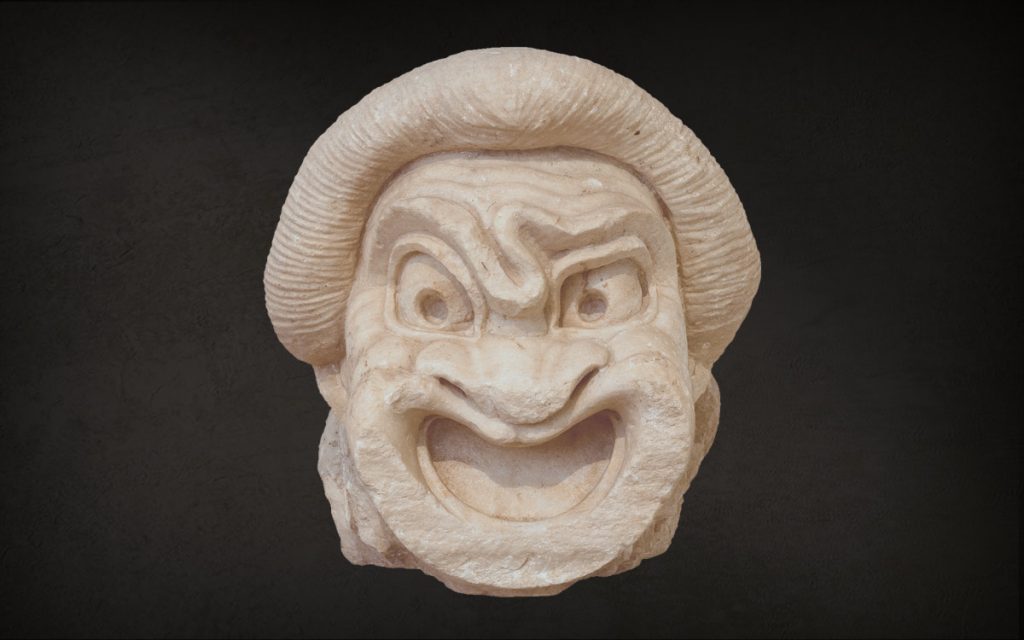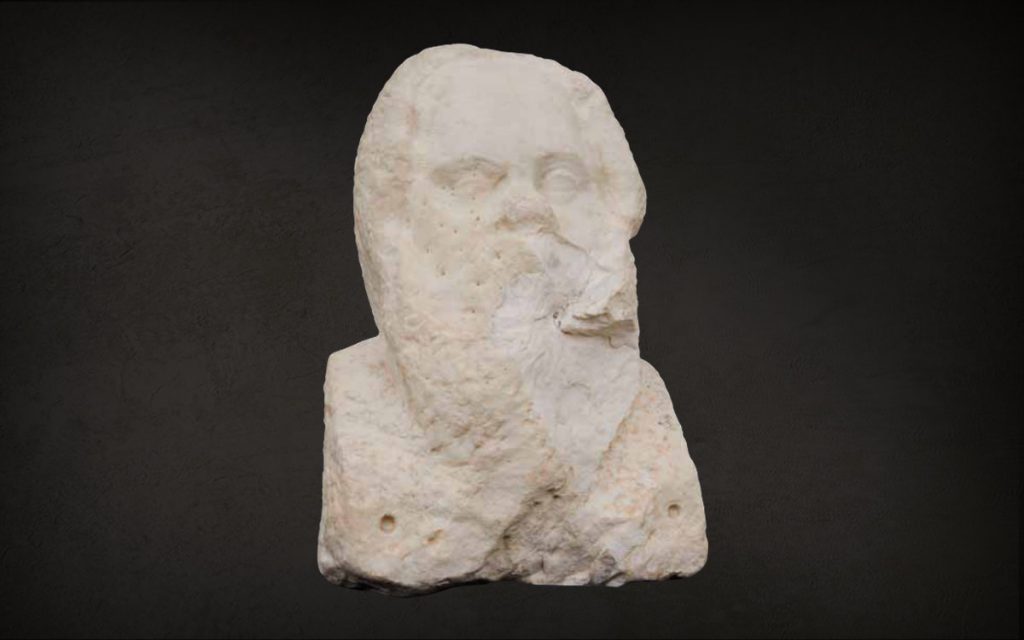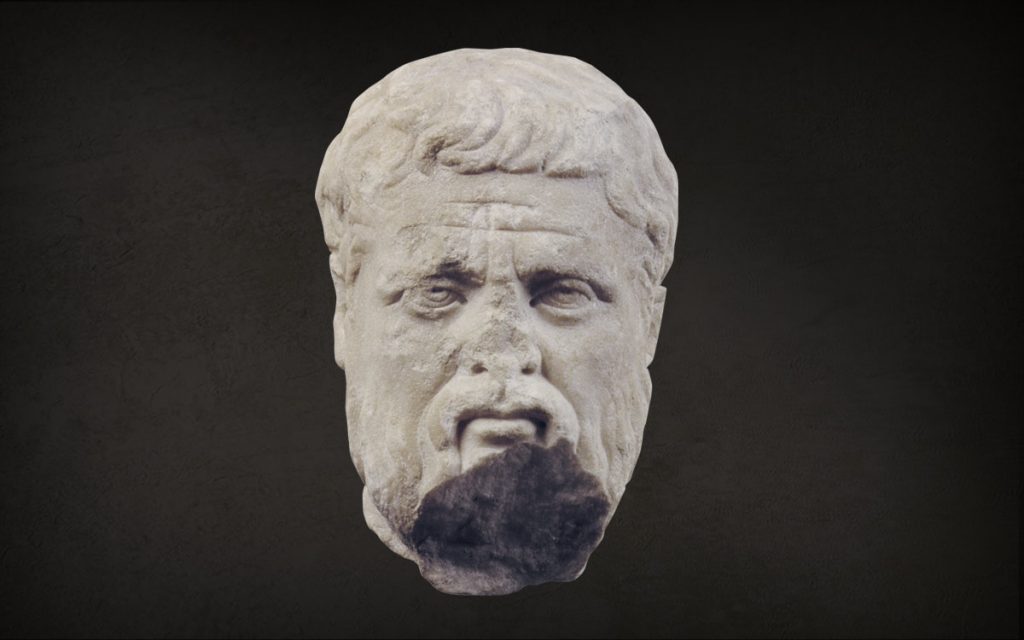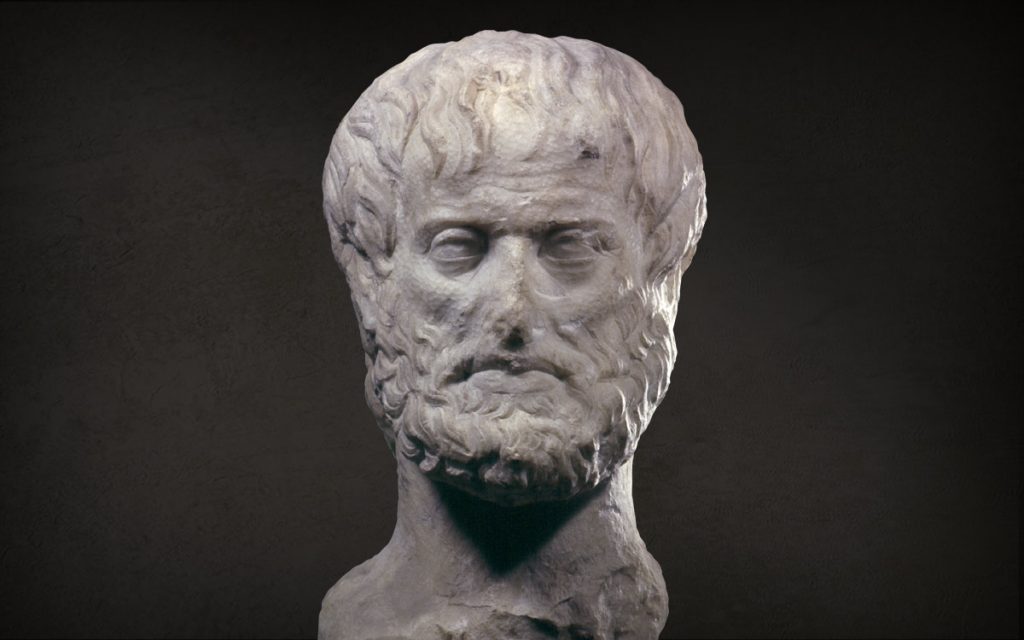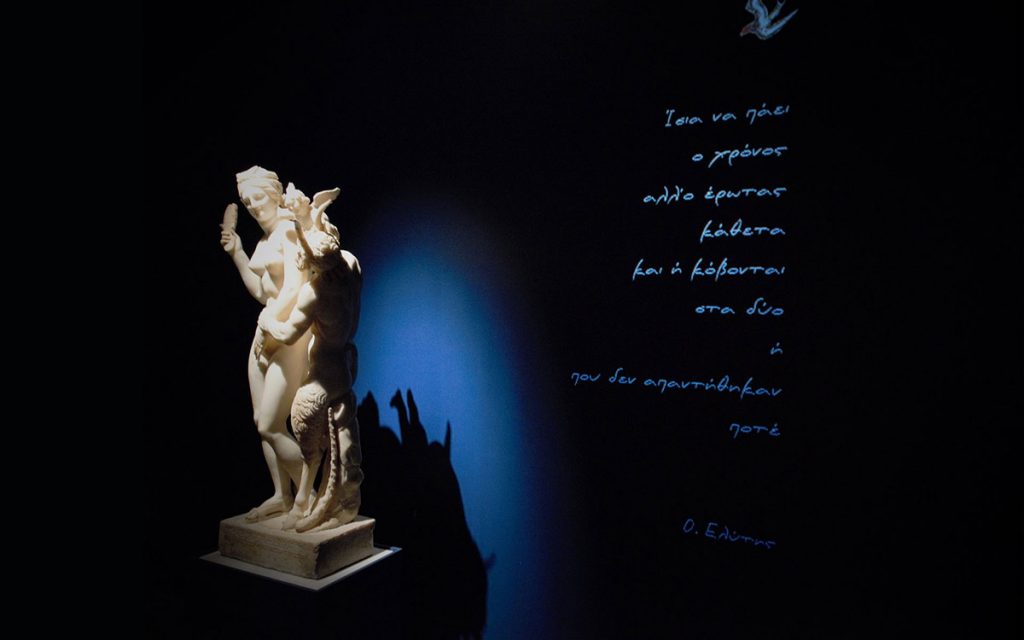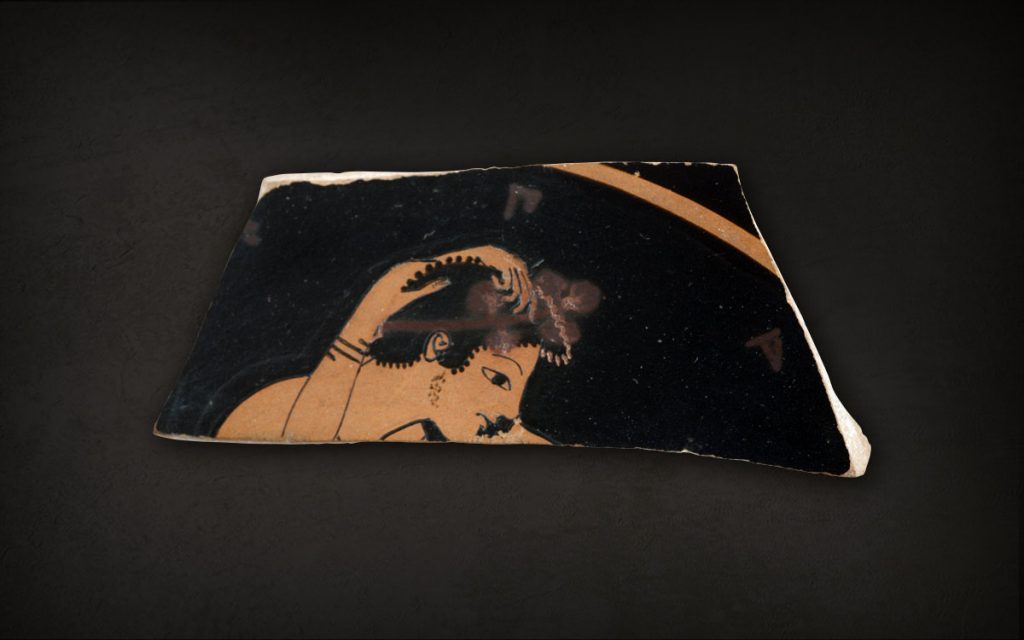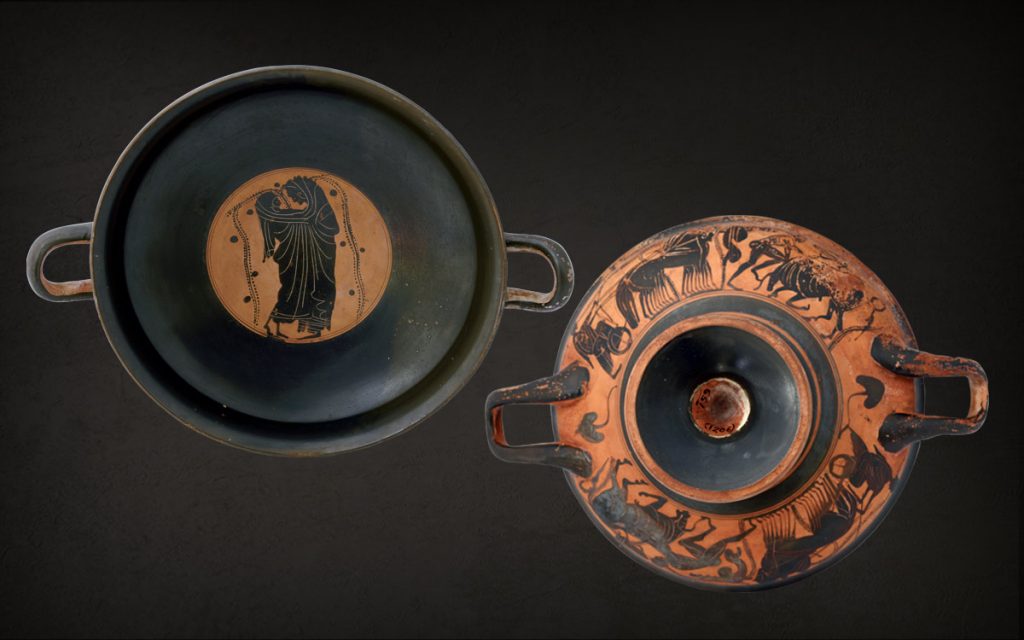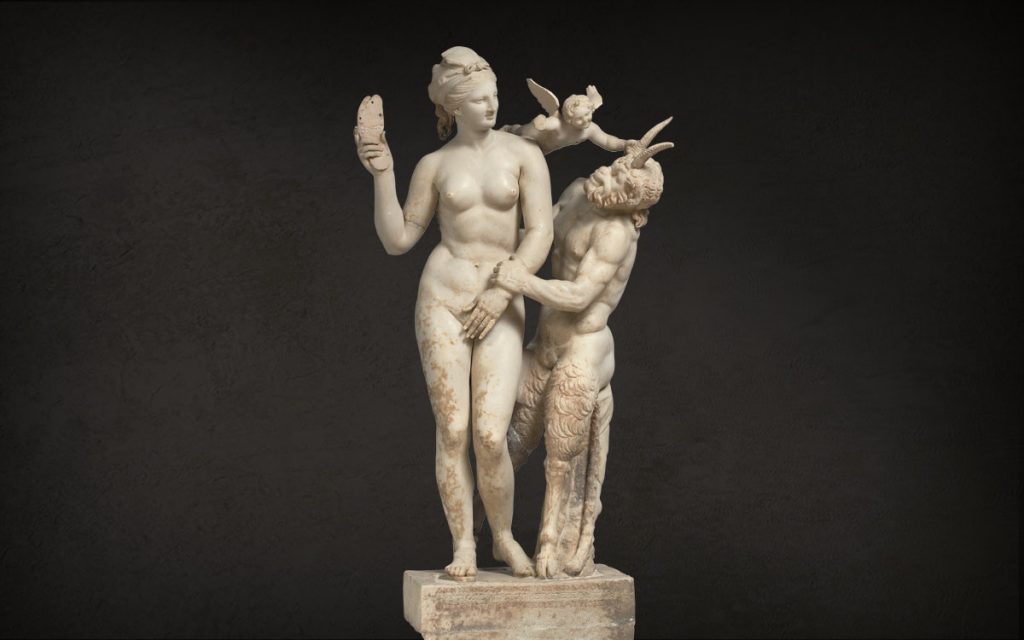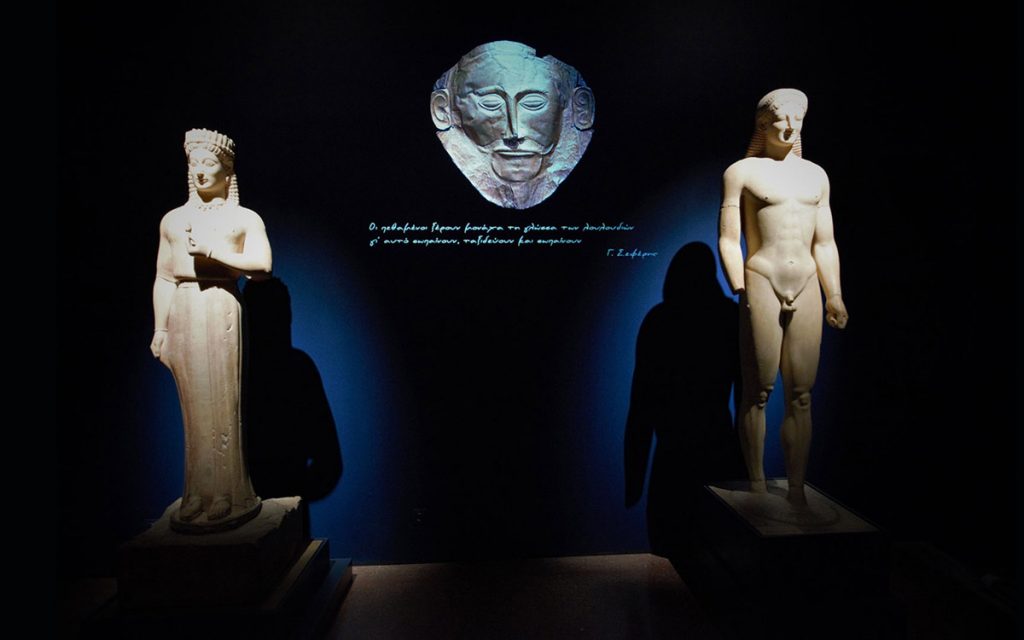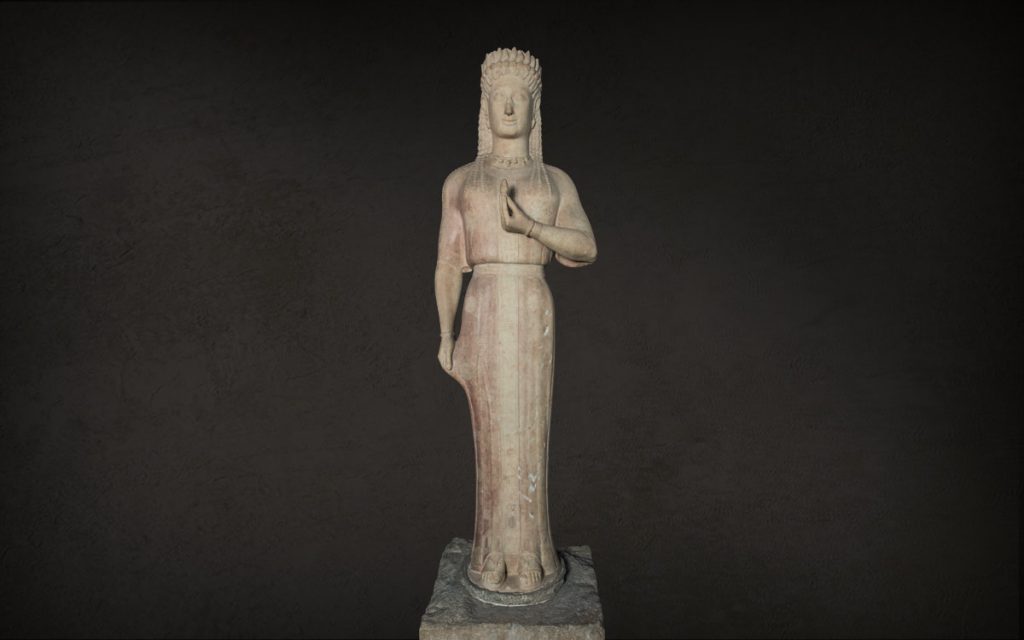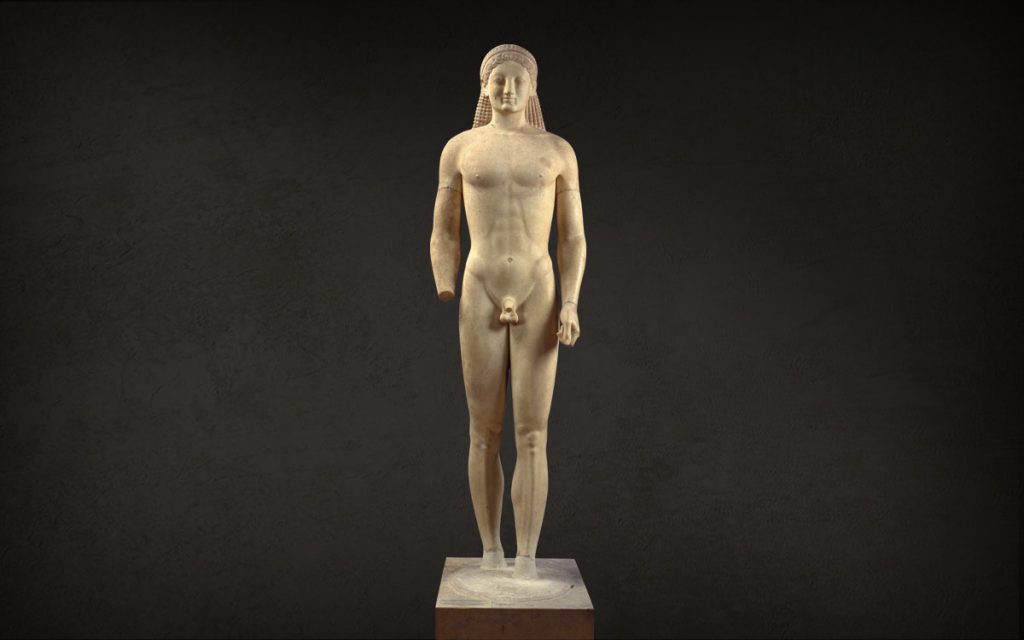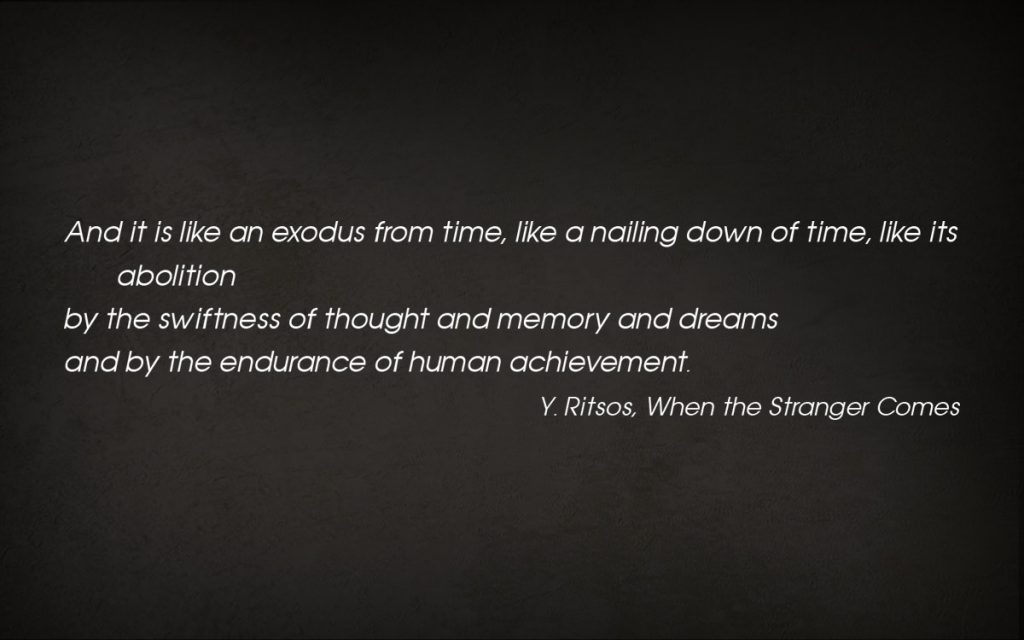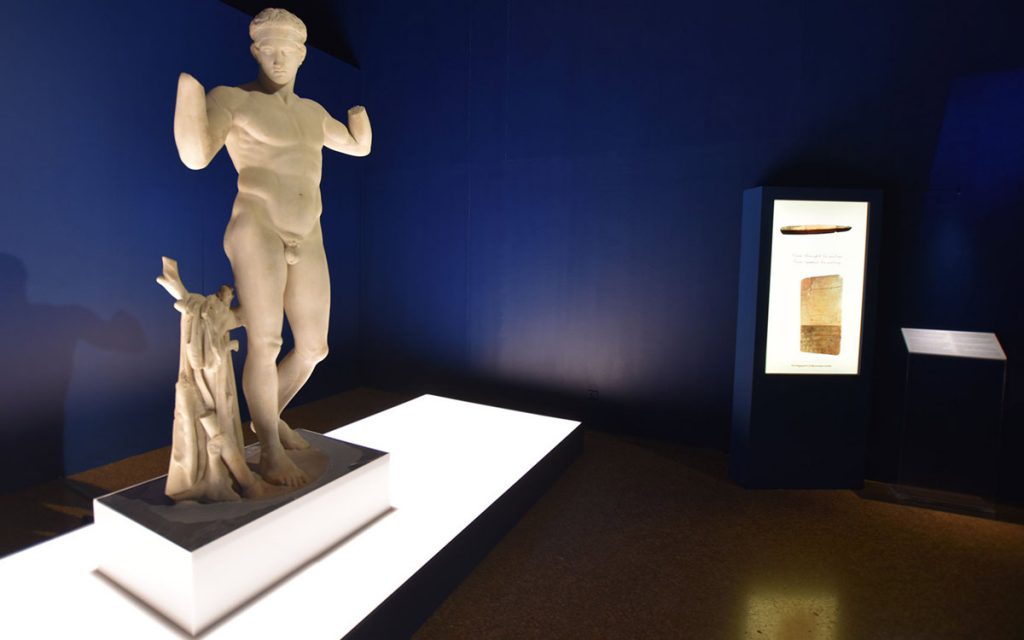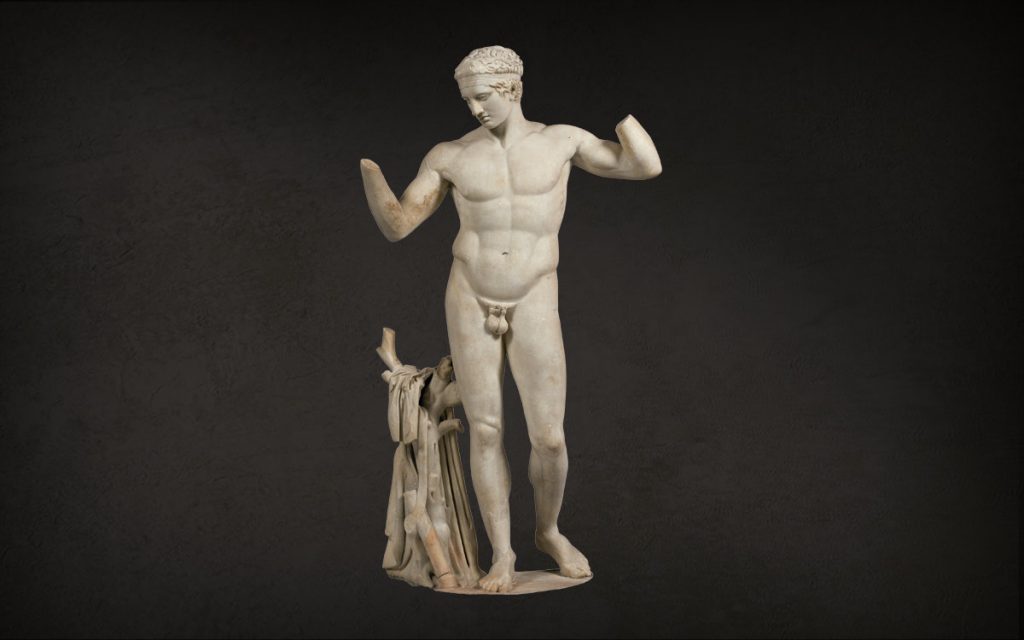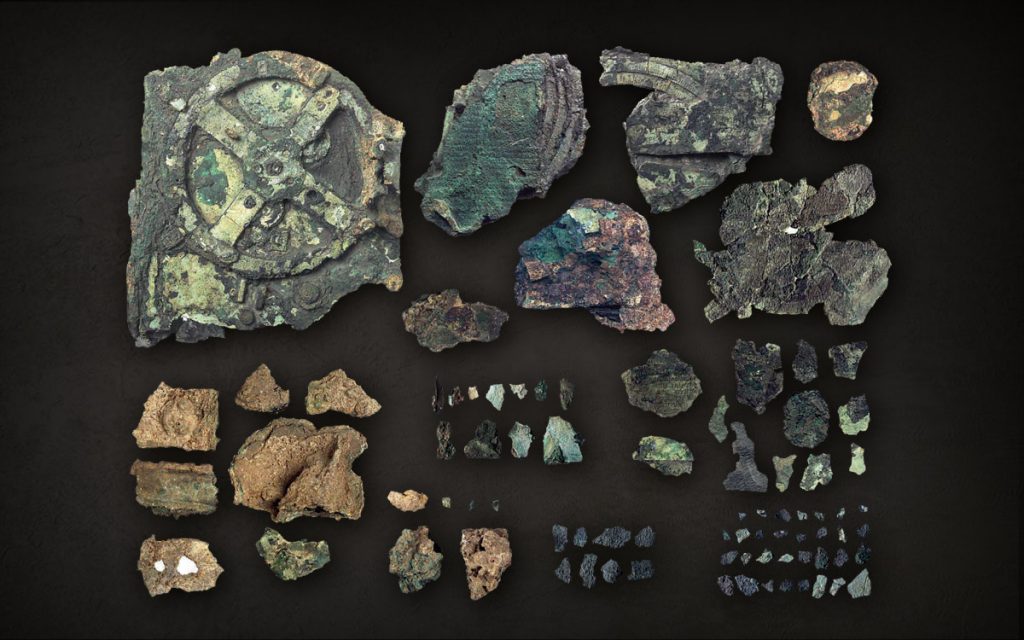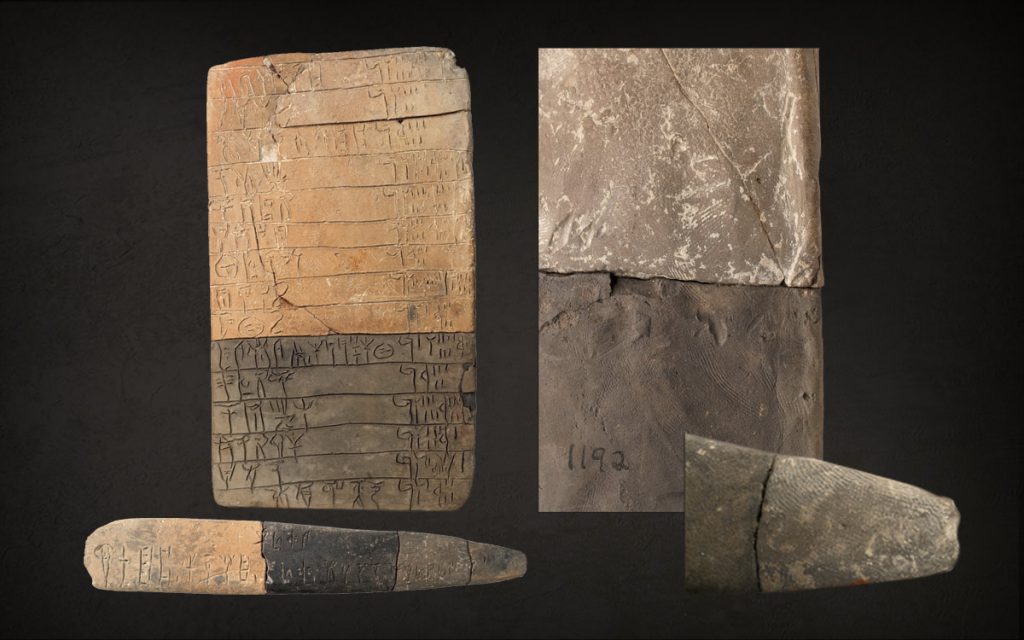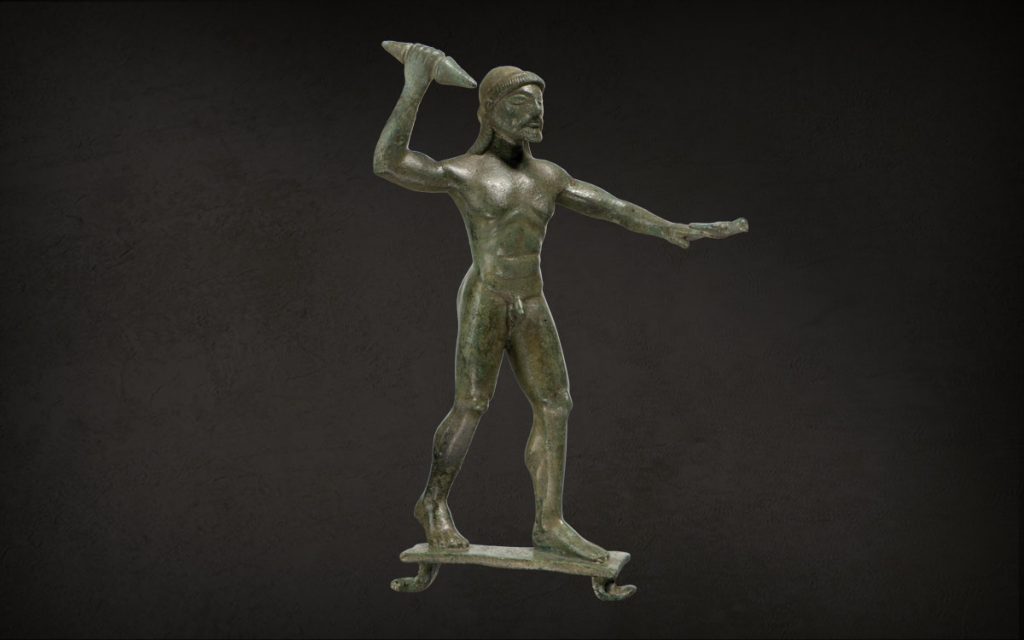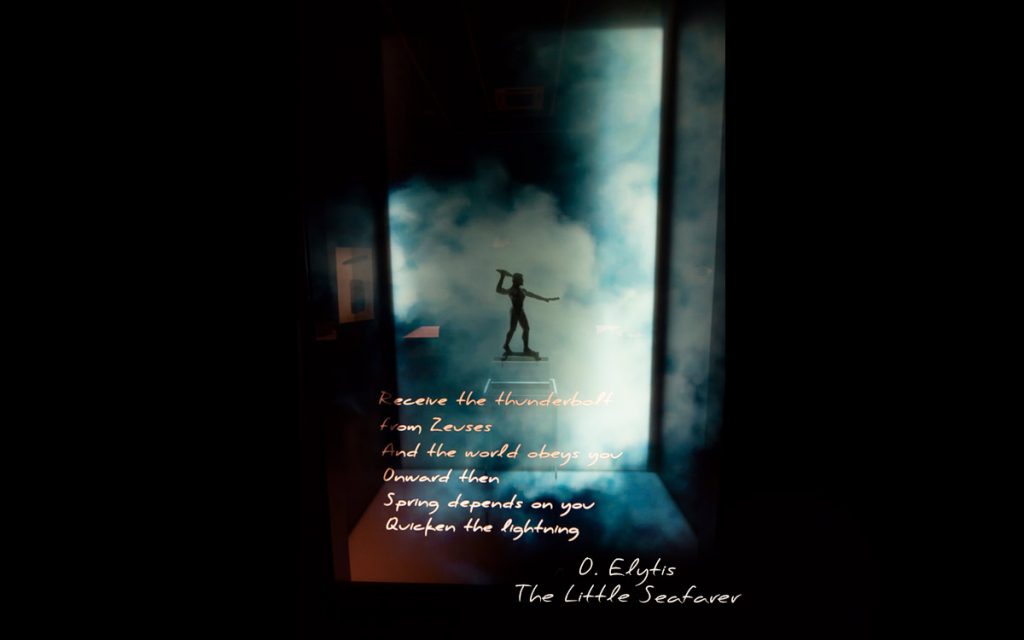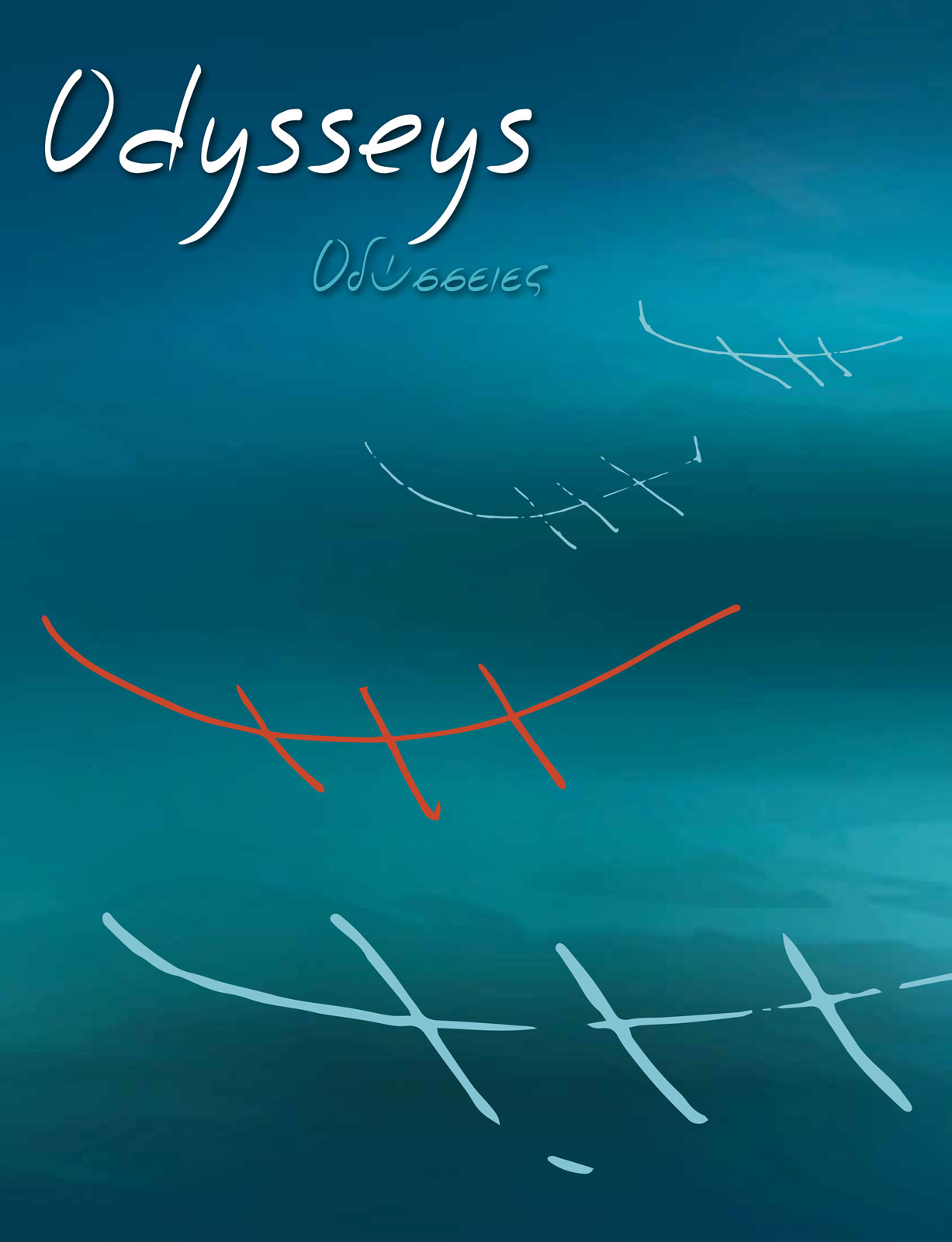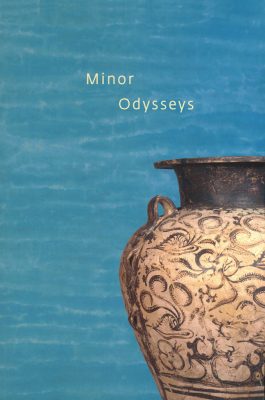
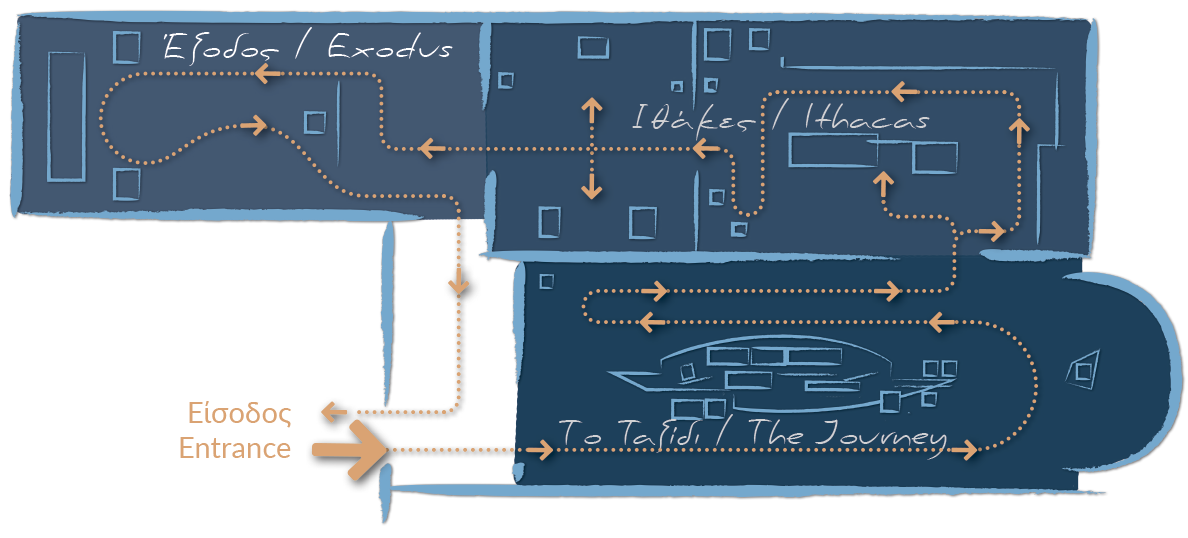
The exhibition narrates histories of men and heroes, known and unknown “Odysseys”, personal and collective ones. Objects from all the collections of the museum and from all the periods are interlinked with the thread of diachrony to recount the “journey” of life through three thematic axes:
THE JOURNEY presents tangible evidence of the ceaseless quest of man for raw materials, knowledge and ideas. Τhe variegated cargo of a conceptual ship and the myths that accompanied the sea journeys of ancient people create an allusive environment of adventure and knowledge.
ITHACAS are inspired by the homecoming (nostos) of Odysseus and devoted to the homelands of all people. Ecumenical ideas and concepts are exemplified by works that embody the collective effort of societies to ensure development and prosperity, as well as the urge of human existence to defy its perishableness.
In the EXODUS, ancient creations symbolically denote great achievements of the human mind and spirit inviting each one of us to pick up the torch of creativity.
The exhibits serve as symbols-signs condensing concepts and ideas. Their diachronic aspects of symbolism are enhanced by the verses of poets, bridging the distance between antiquity and the present
The exhibition marked the celebration of the 150th anniversary of the foundation of the museum in 2016
and was presented from October 4, 2016 to March 24, 2018.

The Journey
In this axis, in a setting that alludes to sea travel, the visitor encounters the enduring evidence of the voyages of the ancients, the myths and the beliefs they encompassed, the material prosperity and spiritual benefits that these offered.
The axis acts in a symbolic manner and implies the incessant search of man for raw materials, knowledge, ideas, the fascination with the challenge of the unknown, the resourcefulness and the strengthening of the soul which results from the struggle against nature and the risks it entails.

Sea routes
Oared and masted ships in military and trading expeditions set up age-old sea routes through the Mediterranean and the Black Sea.
The everlasting relationship of humans with the marine environment and the achievements of ancient people at open sea were vividly depicted in their art.
Clay ‘frying-pan’ vessel
ΝΑΜ, Π4974
One of the earliest depictions of the concept of “the journey”. The spirals probably represent the rolling waves of the perilous and at the same time challenging sea, as a ship sails across it and a fish swims through the waters.
Small clay amphora
ΝΑΜ, Π6098
A large masted warship with fifty rowers is depicted. This is a Mycenaean penteconter (ship with fifty oars), the type of vessel that marked the turbulent history of the end of the great empires in the eastern Mediterranean of 12th c. BC.
Corinthian aryballos
ΝΑΜ, Α281
A ram-bearing ship is here depicted. The helmsman seats on the stern, while standing the boatswain gives signals to the rowers. Seafaring ships, as this one, from various cities travelled in the Mediterranean founding colonies and controlling the sea routes.
Bronze dagger
From Routsi in Messenia. Second half of 16th c. BC.
ΝΑΜ, Π8339
On its blade, the landscape of the sea floor is depicted in unique manner with nautili amongst rocks, corals and shells. In the middle of the composition an enigmatic bird is depicted.
Pithamphora
1500–1450 BC.
ΝΑΜ, Π6725
Three octopuses float in the sea, while rocks, seaweed and anemones compose the seascape. Vases of this kind are considered to be a Mycenaean creation, but their decoration is directly related to Minoan Crete.
Gods and demons, heroic generations
and legendary journeys
Adventures and exploits of mythical heroes in faraway lands preserve the memory of the wanderings of pioneering travellers in their quest for wealth resources and new lands, as well as their struggle against the forces of nature.
Bronze statue of Poseidon
About 480 BC.
ΝΑΜ, Χ11761
Votive offering to Poseidon, as indicated by the inscription on the base: ΤΟ ΠΟΤΕΙΔΑΟΝΟΣ ΗΙΑΡΟΣ. The god, as master of the seas, was worshipped in coastal areas. In his left hand held a trident and in his right hand probably a dolphin.
Statuette of Poseidon
ΝΑΜ, X 16772
The god of the sea must have held in his left hand the trident with which he either calmed the rough waters or stirred up raging waves, determining the fate of travellers and sailing vessels. It is a small-scale version of a 4th c. BC bronze statue, a work of Lyssipos.
Attic black-figured amphora
ΝΑΜ, Α1002
On the neck, Heracles is depicted fighting the centaur Nessos. On the main body, the predominant scene involves the chase of Perseus, great grandfather of Heracles, by the two Gorgons in an effort to revenge the decapitation of their sister, Medusa. The dolphins playing in the waves indicate that this chase took place over the sea.
Black-figured lekythos
ΝΑΜ, Α513
The myth of the encounter of Heracles with Helios (Sun), on the farthest shores of the Ocean, reflects the prior to colonization contacts that the Greek seafarers had with the Iberian peninsula, in their quest of precious metal ores.
Black-figured white-ground lekythos
ΝΑΜ, Α1132
Atlas brings the apples of Esperides to Heracles, who holds up the celestial dome. The garden of Esperides was situated in the westernmost end, beyond the Ocean.
Attic black-figured lekythos
ΕΑΜ, Α 1130
Odysseus, tied to the mast of the ship, withstands the musical call of the Siren. Before him, the Argonauts had managed to pass the island of the Sirens without losing their life.
Figurine of Skylla
ΝΑΜ, Χ 21084
In Odyssey, Skylla, a mythical monster with female fish-tailed body and dog heads, devours the comrades of the hero-traveller.
Marble statuettes of Tritonids
ΝΑΜ, Γ 2171, Γ 2174
The Tritonids, mythical monsters with female upper torso and scaled lower body ending in a double tail, embody the benevolent sea demons who calm storm waves and protect mariners. The statuettes formed part of the throne, on which sat the Great Goddesses (Demeter and Despoina) of the similarly called cult sculptural group in the temple of Lykosoura, work of the Messinian sculptor Damophon.
Valuable cargoes: testimonies to civilizations
Raw materials and goods are circulated in the Aegean from the prehistoric period onwards and throughout historic times.
They form a “cargo” of valuable testimonies: they outline trade networks in the eastern Mediterranean as well as central and north Europe, and reveal the intense contacts and interactions among different civilizations of the ancient world.
Neolithic tools made of obsidian from Melos
ΝAM, Π18311-18404
This black volcanic "glass" from Melos, since Palaeolithic times had been a much sought after raw marerial because of its durability. Cores, flakes and blades illustrate the on site reduction of rock chunks into pieces prepared for tool manufacture, ready to be circulated throughout the Aegean.
Marble Cycladic figurine
ΝΑΜ, Π20934
Large-sized figurine of Spedos type with wide distribution in the Aegean. Τraces of colour are preserved in the area of the hair and eyes. The use of Cycladic figurines remains obscure. Female figurines possibly represent a deity linked to fertility.
Beads and objects of amber (probably parts of necklaces)
ΝAM, Π5688, Π 7936
Amber is the fossilized resin from trees. “Ore deposits” of this material are located along the coast of the Baltic Sea, where from it was transported to the Aegean area, probably through southwest Peloponnese.
Silver rhyton in the shape of a stag
ΝΑΜ, Π388
Vase with two holes for the outflow of liquids. It has been imported from the empire of the Hettites (in Asia Minor) that on a political level rivaled the Mycenaeans.
Ostrich egg rhyton
ΝAM, Π828
Ostrich eggs, imported from Egypt, are transformed by the skillful Minoan and Mycenaean craftsmen into luxury ritual vases for libations.
Clay stirrup jars
14th–13th c. BC.
ΝΑΜ, Π 3561,3562, 2251, 14809
One of the most popular types of vases, it first appears in Minoan Crete and is then imported into mainland Greece. From its shape (the occurrence of a functional spout and a "false"-sealed neck) is inferred that it was used for the transport of liquids,probably of great value, such as perfumed oil.
Tablet of Linear B script
PY Fr1184
It records the delivery of perfumed oils by perfume maker, Kokalos, to his colleague, Eumedes. Perfumed oils, which had beautifying, medical and ritual uses, were the most important exportable product of Mycenaean palatial economy.
Ivory inlay of furniture
EAM, Π7525
The plaque is decorated with opposed sphinxes, imaginary winged creatures with the body of a lion and the head of a woman, which make their first appearance in the Egyptian art.
Horse blinker with Aramaic inscription
ΝΑΜ, Χ 15070
According to the inscription, the blinker was initially given as a gift to Hazael, king of Aram-Damascus, and then dedicated to Apollo. It testifies to the relations between the Eretrians and the people of the Syro-Palestinian coast.
Bowl with inscription in the Aramaic language
ΝΑΜ, Χ 7941
Product of a workshop of the East. Maritime contacts and the development of trade contributed to the wide distribution of this type of vases into the areas of the eastern Mediterranean and mainland Greece.
Marble unfinished kouros (youth)
ΝΑΜ, Γ 14
On the unfinished kouros traces of carving with the point are still visible. Statues of Naxian marble were found at various sites of mainland and insular Greece, while this raw material was exported as far away as Magna Graecia (southern Italy). The fashioning and development of the basic statue types in the Archaic period, such as the type of this kouros, are associated with the artistic tradition of the preceding centuries and influences from Egypt and the Near East.
Lagynoi of various provenances
NAM, A 2354, Α 2397, Α 2176, Α 2170
Lagynoi decorated with wreaths, ivy leaves, fruit bearing branches and musical instruments. The grey one bears moulded relief decoration depicting a Dionysiac thiasos (band). Having a widespread distribution across the eastern Mediterranean, these vases were extensively used in banquets and funerary ceremonies.
The Place
If you deconstruct Greece, you will in the end see
an olive tree, a grape vine, and a boat remain.
That is: with as much, you reconstruct her.
O. Elytis, The Little Seafarer
The Place
Characteristic elements of the Greek nature signal the homecoming of the traveller. Natural landscape coexists and converses with the place of collective action.
Spring Fresco
Late 17th c. BC (Late Cycladic I period)
ΝΑΜ, inv. no. BE 1974.29
This unique work of art has been created using the fresco technique (painting on wet lime plaster), and depicts the Theran landscape in springtime when red sea-lilies bloom among the yellow ochre and red-brown rocks while swallows fly “flirtatiously” among them. The composition is so vivid and the colours are so bright, similarly like it used to be when the room was in use, when the town of Akrotiri was destroyed by a catastrophic volcanic eruption.
Large clay vessel (jug)
ΝΑΜ, ΑΚΡ 623
The wide-mouthed jug may have once contained wine, as indicated by the painted bunches of grape that decorate its surface.
Small clay vessel (askos)
ΝΑΜ, ΑΚΡ 1377
The askos that reached Akrotiri from the neighbouring island of Crete may have once contained perfumed oils. Painted branches of olive tree decorate the upper part of the vase.
Marble votive relief
4th c. BC.
NAM, Γ1914
This is the only relief that depicts at the same time two scenes of the Homeric narrative in the palace of Ithaka, following the perilous return of Odysseus from Troy. On the left, the recognition of the hero by his old nurse, Eurycleia, who, while washing his feet, she spots an old wound on his leg. On the right Penelope is depicted in front of an upright loom.
Marble statue of Odysseus
ΕΑΜ, Γ 5745
Odysseus, wearing a sleeveless short garment (exomis) and the characteristic pointed hat (pilos), strides forcefully forward, while he looks back to see if someone is following him. The ingenious and cunning, well-travelled, king of Ithaka embodies the eternal symbol of the long and strenuous endeavour of man through life.
Reconstructing the timeless Ithacas
Resources – Religion – Hegemony – War – Constitution – Art – Philosophy – Love – Death
The confrontation of Odysseus with the suitors in order to recover his house and kingdom and reinstate his institutional role has given rise to a semiological reconstruction of human action within the context of society. Diachronic acts and situations, meanings and ideas that exceed time function as points of reference: resources and human creation, religion and hegemony, war and claim, state institutions, democracy, philosophy, art and culture and, finally, love and death.
Pithos-jar with rope decoration
ΝΑΜ, Π 6435Α
Storage pithos-jar with symbols of Linear A script that probably indicate, as, later on, the symbols of Linear B script do, the owner or the quantity of products, or they may be associated with the administrative management of the magazines of the Minoan palatial centres.
Gold signet ring
ΝΑΜ, Π 3148
A male figure wearing Minoan dress stands upright before a structure on which has been placed a tree or plant. Behind the man is rendered a wild goat, intended for sacrifice(?). The iconographical composition depicts religious rituals that took place in open-air sanctuaries on Crete and in Mainland Greece, seeking the “epiphany” of the deity, in the form of a tree or a structure or a goddess. Both were likely imported from Crete or were made in Mycenae by Cretan artisans.
Stele with decrees about the temple of Athena Nike
Αcropolis museum ΕΜ 8116
Decisions by the Boule (Council) and the demos (people) of Athens about the reform of the cult of Athena Nike on the Acropolis. Side A: A priestess of the goddess is appointed by lot, with an annual salary of 50 drachmas and, as additional reward, a share of meat from public sacrifices. It is also decided to construct a doorway to the sanctuary. Side B: The kolakretai, a body of financial officers, are designated to be responsible for the payment of the amount to the priestess.
Marble funerary stele
ΝΑΜ, Γ 2309
The anonymous key-bearer priestess holds the key of the temple that was dedicated to the goddess she served, most probably Nemesis. Symbol of a high-ranking priestly office, to which women could ascend too, the key indicates status and it is chosen to accompany the owner in her last depiction over the grave.
Marble head of Athena
ΝΑΜ, Γ 3718
The over life-size head was inserted into a colossal statue of Athena. The goddess wears an Attic helmet with cheek pieces, roughly worked at the back. The statue was a copy of a work by Pheidias or one of his pupils.
Emblematic gold funerary offerings
ΝΑΜ, Π 259, 308, 309, 252, 294
The young “prince” of tomb IV was buried with mask, sceptre and breastplate as well as seven swords, four knives and two daggers that indicated his weapons supremacy in life.
Marble head of Alexander the Great
NAM, Γ 366
Alexander is wearing the lion’s skin, a common feature in the iconography of the Macedonian kings that evokes their heroic descent from Hercules, the legendary ancestor of the Macedonian dynasty.
Clay krater
ΝΑΜ, Π1426
Κnown as “Krater of the Warriors”. It is decorated on both sides with groups of armed men, capturing an image of the military life of the Mycenaeans. The warriors are equipped with helmet, spear, cuirass, while at one end of the scene a woman is bidding farewell or mourning.
Black-figured calyx-krater
ΝΑΜ, Α 26746
Two phalanx formations of hoplitai (infantry) clash for the retrieval of a dead warrior from the battlefield. A scene possibly inspired by the fierce Homeric battle, in which the Achaeans manage in the end to recover Patroclos’ body from the Trojans.
Fragment of a decree stele
EPIGRAPHIC MUSEUM, ΕΜ 6591b
It preserves the decision of the Assembly of the People to send to Sicily sixty ships (HEXΣΕΚΟΝΤΑ ΝΑΥΣ) in response to the appeal of Segesta for help in its conflict with Selinus. This appeal was the pretext for the Sicilian Expedition, an ambitious plan of the Athenians to secure control of Sicily.
Black-figured amphora
ΝΑΜ, Π 15111
The group of four men has been identified with the korynephoroi (club-bearers), the bodyguards of Peisistratos whom they protected from his political rivals. With their assistance, in 538 BC, the tyrant of Athens regained power and ruled until his death (527 BC).
Relief with representation of a hoplitodromos
ΝΑΜ, Γ 1959
A nude youth with Attic helmet is depicted moving to the right in the conventional pose of a runner. This is probably a funerary monument for a hoplite (soldier). According to another view, it represents a dancer of the pyrrichean war dance.
Ostrakon (fragment) from the rim of a clay vessel
ΕΑΜ, Α 11712
The ostrakon with the incised inscription Themistocles/Phrearrios, forms part of the voting with pottery fragments (ostraka) that sent Themistocles into exile, the son of Neocles from the municipality of Phrearrioi (near Anavyssos), probably in 471 or 470 BC. The naval fighter of the Persians at Salamis, after wandering in several Greek cities, ended up in the court of the Persian king, never to return back to Athens.
Attic votive relief
ΝΑΜ, Γ 3344
The naked adolescent, certainly victorious, is depicted at the moment he is crowing himself or getting ready to dedicate his prize to the goddess Athena as a thanksgiving offering for his victory. His expression conveys a profoundly religious feeling. Equally profound also is his political consciousness, an outcome of the democratic freedom of his city
Marble theatrical mask
ΕΑΜ, Γ 3373
Comic mask of a male figure displaying the typical features of the leading slave (hegemon therapon) of the New Comedy. The place it was found indicates a correlation with a certain funerary monument or, most probably, with the Bouleuterion (council chambers) of the Dionysiac Artisans, that was located near Dipylon.
Unfinished bust of Socrates
ΝAM, Γ4897
The rendering of the features illustrates the ethos (moral values) of the great Athenian philosopher, who steered the direction of philosophic contemplation towards the study of the real essence of man, the human soul and virtue.
Portrait head of Plato
ΝΑΜ, Γ3735
The great philosopher with whom the Athenian philosophy reached its apogee, concentrated on writing and teaching in the Academy that he himself founded.
Double-sided head of Aristotle from a hermaic stele
ΝΑΜ, Γ3772
The Stagiritian philosopher Aristotle founded in Athens his own school at the Gymnasium of the Lyceum. He is considered to be the founder of many sciences, as apart from philosophy, he carried out scientific research too.
Fragment of red-figured kylix (cup)
ΝΑΜ, ΑΚΡ.189
A wreathed youth bends over the lips of a woman, ready to kiss her, looking affectionately into her eyes. She embraces his head and caresses with her fingertips his hair.
Black-figured kylix (cup)
ΝΑΜ, Α 651
A man and a woman in an embrace, wrapped up in the same himation (mantle), leave their faces uncovered, while they glance lovingly at each other.
Group of Aphrodite, Pan and Eros
ΝΑΜ, Γ 3335
Aphrodite, naked, possibly in the bath, threatens Pan with her sandal. The winged Eros appears as mediator. Attraction, repulsion, grace, beauty are the components of the erotic game.
Statue of the kore Phrasikleia
ΝΑΜ, Γ 4889
With her right hand she draws up the side of her chiton (robe), while in her left hand holds a lotus flower in front of her breast. A wreath with lotus flowers and buds adorns her head. Phrasikleia will remain forever a girl who will not feel the joy of marriage, as she tells us in the epigram on the pedestal of her monument: “Memorial of Phrasikleia. I shall always be called maiden (kore) having received this name from the gods instead of marriage. Aristion of Paros made me”.
Statue of kouros
ΝΑΜ, Γ 4890
This kouros, like Phrasikleia, adorned the grave of a member of the same prominent family of Mesogeia. The two sculptures had been placed by the relatives in a pit at the ancient cemetery of Myrrhinous, to protect them from an imminent destruction (by the Persian invasion or by political rivals).
Love
Death
Exodus
Works, landmarks for the human intellect, transcend time and take us beyond its limits:
the writing as codification of thought and action, the rendering of the ideal human form, with body and spirit binding together in perfect harmony, the opening to the vastness of the universe with the help of technology.
The journey does not end.
The “thunderbolt” of Zeus has by now been placed into our hands, its energy summons us to creative action…
Statue of the Diadoumenos (youth tying a fillet round his head)
Around 100 BC.
ΝΑΜ, Γ 1826
The young athlete ties a victor’s fillet (band) round his head, a victory that has raised him to the sphere of the gods, as indicated by the Apollonian features of his face. The extended arms and the gilding that once decorated the statue enhance the uplifting quality of this artwork. Marble copy of the similarly called famous bronze statue that the sculptor Polykleitos created around 420 BC, emboding the athletic ideal.
Digital presentation of the “Antikythera Mechanism”
This is the oldest in history astronomical portable computer (150–100 BC), outcome of the development of philosophy and science, that had been achieved in the Helladic region up until then. Its technology points to the successors of Archimedes, Hipparchos and the School of Posidonios in Rhodes. It was found in the Antikythera shipwreck.
Digital presentation of clay tablets in Linear B script from the palace of Pylos
Tablets with accounting data (end of 13th c. BC). The finger and palm prints that can be seen on their surface belong to the scribes in the Mycenaean palaces, to whom we owe the earliest written evidence of the Greek language.
Bronze figurine of “Zeus Keraunios” (Thunderer)
ΝΑΜ, Χ 14984
Attachment of a vase that probably was a votive offering in a sanctuary of Zeus. In his capacity as master of the weather phenomena, Zeus Keraunios is depicted in art with his symbols, the thunder and the lightning, through which he defeats his enemies, manifests his presence and imposes his will.
Bronze figurine of “Zeus Keraunios” (Thunderer)
ΝΑΜ, Χ 14984
View of the work inside the display with digital projection.
Exodus
Minor Odysseys
The exhibition “Minor Odysseys” presented 35 selected antiquities of the National Archaeological Museum, in conjunction with 21 paintings by modern
Greek artists and 21 historic maps from the collections of the Parliamentary Library. It is presented at the Hellenic Parliament Building, from March to November 2017, and was another version of the larger Odysseys exhibition at the National Archaeological Museum.
The Minor Odysseys do not aspire to present exhaustively the idea and all aspects of the major exhibition, but represent a more gestural, artistic and aesthetic approach, since the prehistoric crafted objects interact, in an original way, with the seascapes of modern Greek art, and the prints of European cartography, offering the viewer images of sailing on Greek seas from prehistoric antiquity to modern times, showing its timeless multiple and poetic nature.
The exhibition is structured into three main parts. In the first, entitled “The endless voyage on the Greek seas”, as well as the second on the theme “The sea as source of artistic inspiration”, selected antiquities, the majority of which are from the Museum’s prehistoric collection, commune with paintings by modern Greek artists chosen from the Parliament’s Art Collection, creating selective relations on criteria related to meaning, iconography, style and aesthetics. The third section entitled “The paper Archipelago: The Aegean of the Hellenism” presents outstanding historic maps of the Aegean, which in turn are correlated to the ancient objects and paintings in the two previous sections.
It is precisely this interconnection of modern and contemporary Greeks with their past, that is being attempted through the Minor Odysseys, guided by the archetypal figure of Odysseus, in a great voyage of aesthetics, self-knowledge and cosmopolitanism.
